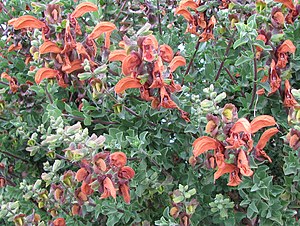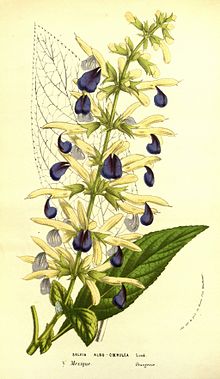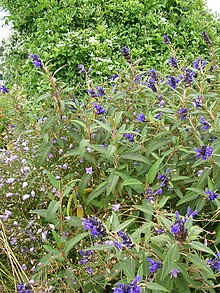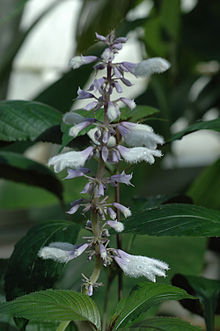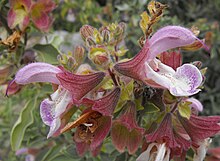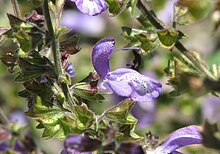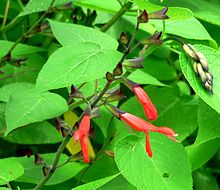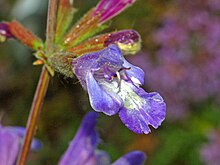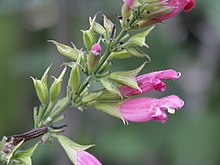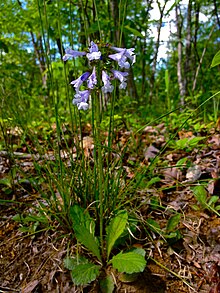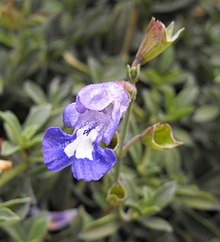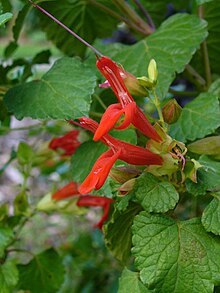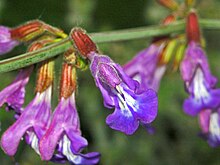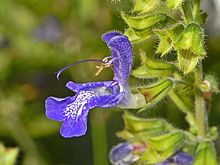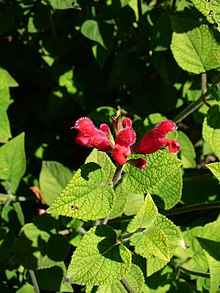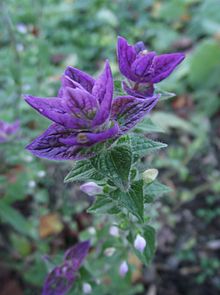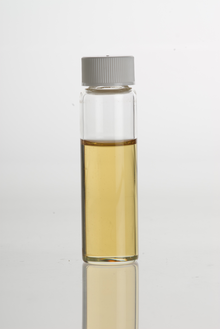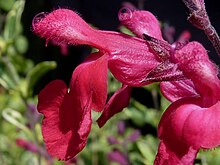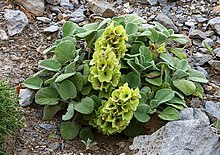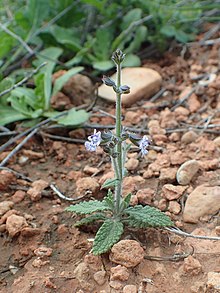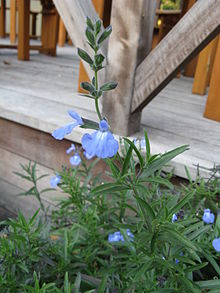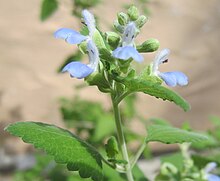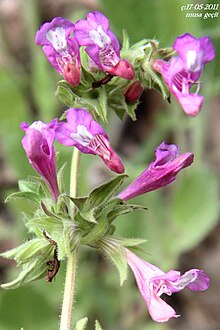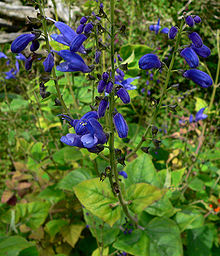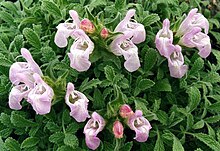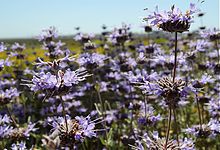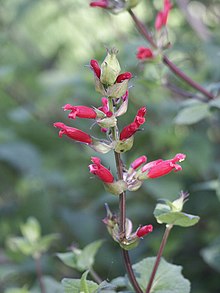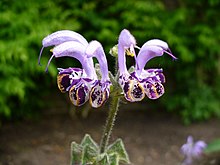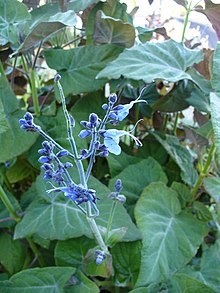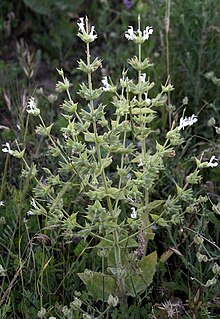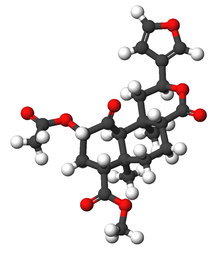
Habit, leaves and inflorescences of the floury sage ( Salvia farinacea )

Inflorescence of Salvia × jamensis 'Sierra San Antonio Gold'

Habit, leaves and inflorescence of woolly sage ( Salvia lanigera )

Habit, leaves and inflorescences of the variety Salvia mexicana 'Limelight'

Salvia nemorosa subsp. pseudosylvestris

Habit, leaves and inflorescences of the nodding sage ( Salvia nutans )

Habitus, leaves and flower head of Spanish sage ( Salvia officinalis subsp. Oxyodon )
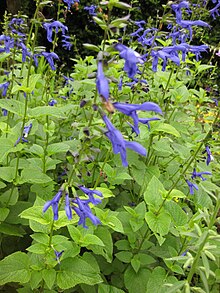
Habitus, leaves and inflorescences of Mexican sage ( Salvia patens )

Habit and inflorescences of Salvia × sylvestris

Habit, leaves and inflorescences of the whorled sage ( Salvia verticillata )
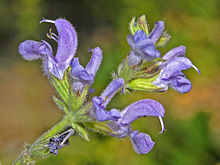
Rod sage ( Salvia virgata ) inflorescence

Zygomorphic flowers of Salvia viscosa , the calyx is also clearly visible
-
Pinnate Perovskia ( Salvia abrotanoides (Kar.) Sytsma , Syn .: Perovskia abrotanoides Kar. , Perovskia artemisioides Boiss. ): It occurs from eastern Iran to Tibet .
-
Salvia absconditiflora Greuter & Burdet ( Salvia cryptantha Montbret & Aucher ex Benth. Nom. Illeg.): It iswidespreadin Turkey .
-
Salvia acerifolia B.L. Turner : It occurs only in the Mexican state of Michoacán .
-
Salvia acuminata Ruiz & Pav .: It occurs in the Peruvian departments of Ancash and Huánuco .
-
Salvia adenocaulon P.H.Davis : It occurs only in southern Turkey.
-
Salvia adenophora Fernald : It is common in southwestern Mexico.
-
Salvia adenophylla Hedge & Hub.-Mor. : It occurs only in southwestern Turkey.
-
Salvia adiantifolia E.Peter : It thrives in foothills and forests in the Chinese provinces of Fujian , Guangdong , Guangxi , Hunan and Jiangxi .
-
Salvia adoxoides C.Y.Wu : This endemic thrives in fields on slopes at an altitude of about 200 meters only in Tian'e County in the Chinese Autonomous Region of Guangxi.
-
Salvia × adulterina Hausskn. : This hybrid of Salvia amplexicaulis × Salvia virgata occurs only in Greece.
-
Salvia aegyptiaca L. (Syn .: Salvia arida Salisb. , Salvia pumila Benth. , Salvia gabrieli Rech. F. ): It is from the Cape Verde Islands and the Canary Islands across northwestern and northern Africa ( Algeria , Morocco , Tunisia , Libya , Egypt ), Sudan , Ethiopia , the Arabian Peninsula Israel , Jordan and Iran as far as Afghanistan , Pakistan and north-western India .
-
Salvia aequidens Botsch. : This endemic occurs only in the Pamir Mountains .
-
Salvia aequidistans Fernald : This endemic occurs only in the southern part of the Mexican state of Sinaloa .
-
Salvia aerea H.Lév. : It thrives at altitudes of 2500 to 3300 meters in the Chinese provinces of Guizhou , Sichuan and Yunnan . It serves as a medicinal plant .
-
Hungarian sage , black sage ( Salvia aethiopis L. ): The wide distribution area extends from Europe to Central Asia .
-
Salvia africana-caerulea L. (Syn .: Salvia acetabulosa L. , Salvia integerrima Mill. , Salvia lanuginosa Burm. F. , Salvia barbata Lam. , Salvia rotundifolia Salisb. , Salvia colorata Vahl , Salvia molucellae Benth. , Salvia undulata Benth. , Salvia subspathulata loam. , Salvia tauricola Schott & Kotschy ex Boiss. ): It occurs only in the South African provinces of Eastern Cape , Northern Cape and Western Cape . It is rated “Least Concern” in the Red List of Endangered Plant Species in South Africa.
-
Salvia africana-lutea L. (Syn .: Salvia lutea L. , Salvia aurea L. , Salvia colorata L. , Salvia eckloniana Benth. ): Italwaysthrives in South Africa (in the provinces of Eastern, Northern and Western Cape) and Namibia near the coast and often on the coastal sand dunes from Namaqualand to the Cape Peninsula and to Port Alfred . It is used as an ornamental plant. It is rated “Least Concern” in the Red List of Endangered Plant Species in South Africa.
-
Salvia akiensis A.Takano, Sera & N. Kurosaki : It wasfirst describedin 2014 from the Japanese island of Honshu .
-
Salvia alamosana Rose : It occurs only in the Mexican state of Sonora .
-
Salvia alatipetiolata Sun : It thrives on grassy slopes at an altitude of about 3800 meters only in the Chinese province of Sichuan.
-
Salvia alata Epling : It is common in Peru.
-
Salvia alba J.RIWood : It is common in Bolivia and north-western Argentina .
-
Salvia albicalyx J.G. González : It wasfirst describedin 2013 from the Mexican state of Durango .
-
Salvia albicaulis Benth. (Syn .: Salvia dregeana Benth. ): It occurs only in the South African province of Western Cape . It is rated “Least Concern” in the Red List of Endangered Plant Species in South Africa.
-
Salvia albiflora M. Martens & Galeotti (Syn .: Salvia drymocharis Epling ex Standl. ): The distribution area extends from Mexico to Costa Rica .
-
Salvia albimaculata Hedge & Hub.-Mor. : It occurs only in southern Turkey.
-
Salvia albiterrarum J.G. González & Art.Castro : It wasfirst describedin 2013 from the Mexican state of Jalisco .
-
Salvia albocaerulea Linden : It is common in southwestern Mexico.
-
Salvia alborosea Epling & Játiva : It is common in Ecuador and Peru .
-
Salvia alexeenkoi Pobed. : It occurs in the Caucasus region.
-
Salvia algeriensis Desf. : The homeland is Algeria and Morocco.
-
Salvia aliciae E.P.Santos : It is common in southern and southeastern Brazil.
-
Salvia altissima Pohl : It is common in southeastern Brazil.
-
Salvia alvajaca Oerst. (Syn .: Salvia tiliifolia var. Alvajaca (Oerst.) LOWilliams , Salvia ourophylla Briq. , Salvia permixta Briq. , Salvia inaequilatera Cufod. ): It iswidespreadfrom Nicaragua to Panamá .
-
Salvia amethystina Sm .: The four subspecies are common in Colombia and northwestern Venezuela.
-
Salvia amissa Epling : The home is southern Arizona .
-
Salvia amplexicaulis Lam. : It iswidespreadin Southeastern Europe from the former Yugoslavia, Albania , Bulgaria to Greece and also in Turkey .
-
Salvia amplicalyx E.Peter : This endemic is only Sikkim before.
-
Salvia amplifrons Briq. : It occurs only in central Bolivia.
-
Salvia anastomosans Ramamoorthy : It occurs in the Mexican state of Oaxaca .
-
Salvia anatolica Hamzaoglu & A.Duran : The home is central and eastern Turkey.
-
Salvia andreji Pobed. : This endemic occurs in Azerbaijan only in Nakhichevan and in the vicinity of the village of Buzgov in the Shakhbuz district. This species is common in these small areas. It is collected in the wild for decoration purposes, this could endanger this species in the future.
-
Salvia anguicoma Epling : The home is northwestern Venezuela.
-
Salvia angulata Benth. : It is common in Panama , Colombia, Ecuador and Venezuela.
-
Salvia angustiarum Epling : It is common in southwestern Mexico.
-
White sage , Indian smoked sage ( Salvia apiana Jeps. ): It occurs only from southern California to the Mexican state of Baja Norte . It is used in many ways.
-
Salvia apparicii Brade & Barb. Per . : It is common in southeastern Brazil.
-
Salvia appendiculata E. Peter : It thrives on the open banks of flowing waters , in thickets and in forests only in the northern part of the Chinese province of Guangdong.
-
Salvia arabica Al-Musawi & Weinert : It only occurs in Iraq.
-
Salvia aramiensis Rech. F. : It occurs from southern Turkey to Syria.
-
Salvia arborescens Urb. & Ekman : It only occurs on the island of Hispaniola .
-
Salvia arduinervis Urb. & Ekman : It is endemic to the Massif de la Selle in Haiti.
-
Salvia arenaria A.St.-Hil. ex Benth. : It is common in southeastern Brazil.
-
Salvia areolata Epling (Syn .: Salvia sparsiflora Epling ): The home is Guatemala.
-
Salvia areysiana Deflers : It only occurs in Yemen .
-
Silver sage or silver leaf sage ( Salvia argentea L. ): It is common in the Mediterranean region.
-
Salvia ariana Hedge : The two varieties are found in Afghanistan.
-
Salvia aridicola Briq. : The home is Paraguay.
-
Salvia aristata Aucher ex Benth. : The distribution area extends from eastern Turkey to western and northern Iran.
-
Salvia arizonica A.Gray : It occurs from western Texas to southern Arizona and northeastern Mexico.
-
Salvia arthrocoma Fernald : It is common in northeastern Mexico.
-
Salvia articulata Epling : It is common in southeastern Brazil.
-
Salvia aspera M. Martens & Galeotti : It is common in central and southwestern Mexico.
-
Salvia asperata Falc. ex Benth. : It is common in the Himalayas .
-
Salvia assurgens Kunth : It is common in Mexico.
-
Salvia atrocalyx Epling : It is common in Peru.
-
Salvia atrocyanea Epling : It is common in Bolivia and northwestern Argentina.
-
Salvia atropaenulata Epling : It is common in southwestern Mexico.
-
Salvia atropatana Bunge (Syn .: Salvia bachtiarica Bunge , Salvia hypochionea Buhse ex Boiss. , Salvia kopetdaghensis Kudr. , Salvia linczevskii Kudr. , Salvia kourossia Parsa , Salvia lurorum Rech. F. , Salvia linguifolia Hedge & Hub.-Mor. ): It iswidespreadfrom southeastern Turkey via Iraq to Iran .
-
Salvia atropurpurea C.Y.Wu : It thrives on grass slopes at an altitude of around 3400 meters only in the Chinese province of Yunnan .
-
Salvia atrorubra C.Y.Wu : It thrives in forests at an altitude of about 2700 meters only in the Chinese province of Yunnan .
-
Salvia aucheri Benth. : The two subspecies are common in southern Turkey:
-
Salvia aucheri Benth. subsp. aucheri
-
Salvia aucheri subsp. canescens (Boiss. & Heldr.) Celep, Kahraman & Dogan
-
Salvia × auriculata Mill .: This hybrid of Salvia fruticosa × Salvia officinalis is widespread in southern Europe.
-
Salvia aurita L. f. (Syn .: Salvia sylvicola Burch. Ex Benth. , Salvia lasiostachys Benth. , Salvia pallidifolia Skan , Salvia peglerae Skan , Salvia galpinii Skan ): It comes in two varieties in Swaziland and in the South African provinces of Western Cape , Eastern Cape , KwaZulu-Natal as well Mpumalanga before. Both varieties are rated in the Red List of Endangered Plant Species in South Africa as “Least Concern” = “not endangered”.
-
Austrian sage ( Salvia austriaca Jacq. , Syn .: Salvia sclaraea Crantz nom. Illeg., Salvia bavarica cupboard , Sclarea distans Moench , Salvia distans (Moench) Pohl ): It is from Central Europe (e.g. Austria , Hungary , Czech Republic ) over Southeast Europe to distributed to the southern European part of Russia .
-
Salvia austromelissodora Epling & Játiva : This rare subshrub is only known from a single collection in 1960 on the road from Loja to San Lucas in the Ecuadorian province of Loja . But it may be that it occurs in the “Parque Nacional Podocarpus”. It is rated "Vulnerable" in the IUCN Red List of Endangered Species.
-
Salvia axillary Moc. & Sessé ex Benth. : The three varieties are common in Mexico.
-
Salvia axilliflora Epling : The home is northern Venezuela.
-
Salvia ayavazensis Kunth : It is common in Peru.
-
Salvia aytachii Vural & Adigüzel : The home is Turkey.
-
Plains sage ( Salvia azurea Michx. Ex Vahl , Syn .: Salvia mexicana Walter nom. Illeg., Salvia acuminata Vent. Nom. Illeg., Salvia angustifolia Michx. Nom. Illeg., Salvia elata Poir. , Salvia elongata Torr. Nom . illeg., Salvia pitcheri Torr. ex Benth. , Salvia acuminatissima Steud. , Salvia coriifolia Scheele ): None of the earlier subtaxa is recognized today. This species is common in the western-central and southern United States .
-
Salvia bahorucona Urb. & Ekman : It occurs only in the southern part of Hispaniola in the Massif de la Selle and the Sierra Baoruco .
-
Salvia baimaensis S.W.Su & ZAShen : This endemic thrives on slopes at altitudes of 600 to 1400 meters only in Jinzhai Xian in the Chinese province of Anhui.
-
Salvia balansae Noë ex Coss. : The home is Algeria.
-
Salvia balaustina Pohl : It is widespread in southeastern Brazil.
-
Salvia baldshuanica Lipsky : It is common in Central Asia.
-
Salvia ballotiflora Benth. (Syn .: Salvia laxa Benth. ): It occurs from Texas to northeast Mexico. It is used as a herbal tea.
-
Salvia ballsiana (Rech. F.) Hedge : Home is Turkey.
-
Salvia bariensis Thulin : The home is northern Somalia .
-
Salvia barrelieri Etl. : It is widespread from southwest Spain via Algeria, Tunisia to Morocco.
-
Salvia bazmanica Rech. F. & Esfand. : The home is southern Iran.
-
Salvia beckeri Trautv. : The homeland is the Caucasus .
-
Salvia benthamiana Gardner ex Fielding : It is endemic to the Serra dos Órgãos in the Brazilian state of Rio de Janeiro .
-
Salvia × bernardina Parish ex Greene : This hybrid of Salvia columbariae × Salvia mellifera occurs in California.
-
Salvia betulifolia Epling : The two varieties are only found in northeastern Mexico.
-
Salvia bifidocalyx C.Y.Wu & YCHuang : It thrives in rocky mountain areas at an altitude of around 3500 meters only in the Chinese province of Yunnan .
-
Salvia biserrata M. Martens & Galeotti : It occurs only in the Mexican state of Veracruz .
-
Salvia blancoana Webb & Heldr. : There are five subspecies:
-
Salvia blancoana subsp. amethystea (Emb. & Maire) Figuerola : It occurs in Morocco.
-
Salvia blancoana Webb & Heldr. subsp. blancoana : It occurs in southeastern Spain and in northern Algeria.
-
Salvia blancoana subsp. mariolensis Figuerola : It occurs in eastern Spain.
-
Salvia blancoana subsp. maurorum (ball) W.Lippert : It occurs in Morocco.
-
Salvia blancoana subsp. mesatlantica (Maire) Figuerola : It occurs in Morocco.
-
Salvia blancoana subsp. vellerea (Cuatrec.) W.Lippert : It occurs in southern and eastern Spain.
-
Salvia blepharochlaena Hedge & Hub.-Mor. : The home is Turkey.
-
Salvia blepharophylla Brandegee ex Epling : It occurs only in the northern Mexican state of San Luis Potosí .
-
Salvia boegei Ramamoorthy : It occurs only in the Mexican state of Puebla .
-
Salvia bogotensis Benth. : The four subspecies are all found in Colombia:
-
Salvia bogotensis subsp. aratocensis J.RIWood & Harley
-
Salvia bogotensis subsp. bogotensis
-
Salvia bogotensis subsp. sochensis J.RIWood & Harley
-
Salvia bogotensis subsp. suratensis J.RIWood & Harley
-
Salvia booleana B.L.Turner : It is distributed in northeastern Mexico.
-
Salvia borjensis E.P.Santos : It is distributed in Argentina and southern Brazil.
-
Salvia bowleyana Dunn : It thrives in two varieties on slopes, on rivers, in forests and in valleys at altitudes of 0 to 1000 meters in the Chinese provinces of Fujian, Guangdong, Guangxi, Hunan , Jiangxi and Zhejiang .
-
Salvia brachyantha (Bordz.) Pobed. : There are two subspecies:
-
Salvia brachyantha (Bordz.) Pobed. subsp. brachyantha : It occurs from eastern Turkey to northwestern Iran.
-
Salvia brachyantha subsp. tankutiana Bagh., Celep, Kahraman & Dogan : It occurs in Turkey.
-
Salvia brachyloba Urb. : It only occurs on the island of Hispaniola .
-
Salvia brachyloma E. Peter : It thrives on alpine mats and wooded grasslands at altitudes of 3200 to 3800 meters in the Chinese provinces of Sichuan and Yunnan.
-
Salvia brachyodon Vandas : The home is the northwestern Balkan Peninsula.
-
Salvia brachyodonta Briq. : It occurs in the Mexican states of Zacatecas and Jalisco .
-
Salvia brachyphylla Urb. : It only occurs on the island of Hispaniola.
-
Salvia bracteata Banks & Sol. : The distribution area extends from the eastern Mediterranean to western Iran.
-
Salvia brandegeei Munz : It is distributed from California to the Mexican state of Baja California .
-
Salvia breviconnectivata Y.Z.Sun ex CYWu : This endemic thrives on roadsides at an altitude of around 1800 meters only in Lunan Xian in the Chinese province of Yunnan.
-
Salvia breviflora Moc. & Sessé ex Benth. : It is common in central and southwestern Mexico.
-
Salvia brevilabra Franch. (Syn .: Salvia souliei Duthie ex JHVeitch non H.Lév. , Salvia blinii H.Lév. ): It thrives on slopes, on grasslands and in forests at altitudes of 3200 to 3800 meters only in the Chinese province of Sichuan.
-
Salvia brevipes Benth. : It is common from Brazil to Paraguay and Argentina.
-
Salvia broussonetii Benth. (Syn .: Salvia bolleana de Noé ex Bolle , Salvia broussonetii Bolle nom. Illeg.): This endemic probably only occurs on Tenerife , an occurrence on Lanzarote is not certain.
-
Salvia buchananii hedge : This endemic occurs only in the northeastern part of the Mexican state of Querétaro . It is also used as an ornamental plant.
-
Salvia bucharica Popov (Syn .: Salvia honigbergeri Rech. F. ): It iswidespreadfrom the Pamir Mountains to Afghanistan and Pakistan.
-
Salvia buchii Urb. : It is endemic to Haiti .
-
Salvia bulleyana Diels : It thrives on slopes at altitudes of 2100 to 3400 meters only in the Chinese province of Yunnan .
-
Salvia bullulata Benth. : It is common in Peru.
-
Salvia bungei J.G. González (Syn .: Perovskia virgata Kudrjasch. ): It occurs in Tajikistan.
-
Salvia caaguazuensis Briq. : The homeland is southeast Paraguay.
-
Salvia cabonii Urb. : It is endemic to Haiti.
-
Salvia cabulica Benth. : It occurs only in eastern Afghanistan and in Pakistani Baluchistan .
-
Salvia cacaliifolia Benth. : The home is Mexico and Guatemala.
-
Salvia cacomensis J.G. González, JGMorales & JLRodr. : It was first described in 2012 from the Mexican state of Jalisco.
-
Salvia × cadevallii Sennen : This hybrid of Salvia pratensis × Salvia verbenaca occurs in Spain.
-
Salvia cadmica Boiss. : It occurs in two varieties in Turkey.
-
Salvia caespitosa Montbret & Aucher ex Benth. : The homeland is central and southern Turkey.
-
Salvia calaminthifolia Vahl : It is endemic to Haiti.
-
Salvia calcicola Harley : The home is western and central Brazil.
-
Salvia calderoniae Bedolla & Zamudio : It wasfirst describedin 2015 from the Mexican state of Guanajuato .
-
Salvia californica Brandegee : This endemic occurs only in the western part of the Mexican Baja California Sur .
-
Salvia calolophos Epling : The home is the Argentine province of Jujuy and the province of Salta .
-
Salvia camarifolia Benth. : The two subspecies are only found in Colombia:
-
Salvia camarifolia Benth. subsp. camarifolia
-
Salvia camarifolia subsp. ibiricensis Fern.Alonso
-
Salvia campanulata Wall. ex Benth. (Syn .: Salvia codonantha E. Peter ): It is common in the Himalayas from India , Bhutan , Sikkim , Nepal , northern Myanmar and the autonomous region of Tibet to Yunnan. In the Flora of China 1994 this species is divided into several varieties, not by some other authors.
-
Salvia campicola Briq. : It occurs in Paraguay.
-
Salvia camporum Epling : It is common in Peru.
-
Salvia campylodonta botsch . : It is widespread in Central Asia.
-
Salvia cana Wall. ex Benth. (Syn .: Salvia integrifolia Hardw. Nom. Illeg., Salvia lanata Roxb. Nom. Illeg., Salvia mukerjeei Bennet & Raizada ): It iswidespreadin the Himalayas from Pakistan to Nepal.
-
Canary Sage ( Salvia canariensis L. ): It occurs only in the Canary Islands .
-
Salvia candelabrum Boiss. (Syn .: Salvia candelabriformis St.-Lag. ): It occurs only in southern Spain.
-
Salvia candicans M.Martens & Galeotti : It is common in Mexico.
-
Pure white-flowered sage ( Salvia candidissima Vahl ): It is distributed in two subspecies from southern Albania to western Greece and from Turkey to northern Iraq.
-
Salvia canescens C.A.Mey. : The two varieties are common in the Caucasus region.
-
Salvia capillosa Epling : It occurs only in the Mexican state of Michoacán .
-
Salvia carbonoi Fern.Alonso : The home is Colombia.
-
Salvia cardenasii J.RIWood : The home is Bolivia.
-
Salvia cardiophylla Benth. : The distribution area extends from Bolivia to northeast Argentina.
-
Thistle Sage ( Salvia carduacea Benth. , Syn .: Salvia gossypina Benth. ): It occurs only from California to the Mexican state of Baja Norte. The Klausen of this annual type are used.
-
Salvia carnea Kunth (Syn .: Salvia ionocalyx Epling ): The distribution area extends from Mexico to Guatemala and from Costa Rica to Venezuela and Ecuador.
-
Salvia carranzae Zamudio & Bedolla : It wasfirst describedin 2015 from the Mexican state of Querétaro .
-
Salvia carreyesii J.G. González : It was first described in 2013 from the Mexican state of Jalisco.
-
Salvia carrilloi Véliz & Quedensley : It was first described in 2011 from Guatemala.
-
Salvia cassia Sam. ex Rech. f. : The distribution area extends from southern Turkey to western Syria.
-
Salvia castanea Diels : It occurs in Sichuan, Yunnan, in the autonomous region of Tibet and in Nepal.
-
Salvia cataractarum Briq. : It only occurs in Colombia.
-
Salvia caudata Epling : It is common in northeastern Mexico.
-
Salvia cavaleriei H.Lév. : The three varieties thrive on slopes, on rivers and in forests at altitudes of 500 to 2700 meters in the Chinese provinces of Guangdong, Guangxi, Guizhou, Hubei, Hunan, Jiangxi, Shaanxi, Sichuan and Yunnan.
-
Salvia caymanensis Millsp. & Uline : She is endemic to Grand Cayman Island. This species was thought to be extinct by the time it was rediscovered in July 2007 in two distant locations in eastern Grand Cayman. It only thrives on roadsides and no longer in the former locations on sandy coastal areas. In 2013 it was estimated that around 400 specimens are still wild. There are cultivated specimens. It is in the IUCN 2013 Red List of Threatened Species as “Critically Endangered”.
-
Salvia cedronella Boiss. : The home is southwestern Turkey.
-
Salvia cedrosensis Greene : It is endemic to the Mexican island of Isla de Cedros .
-
Salvia ceratophylla L .: The distribution area extends from the eastern Mediterranean to Afghanistan.
-
Salvia cerinopruinosa Rech. F. : The homeland is eastern and central Turkey.
-
Salvia × cernavodae Nyár. : This hybrid of Salvia amplexicaulis × Salvia nutans occurs in Southeastern Europe .
-
Salvia cerradicola E.P.Santos : It occurs in the Brazilian states of Goiás and Minas Gerais.
-
Salvia chalarothyrsa Fernald : It is common in southwestern Mexico.
-
Salvia chamaedryoides Cav. (Syn .: Salvia chamaedrys Willd. , Salvia chamaedrifolia Andrews , Salvia menthifolia Ten. ): It is common in the Mexican states of San Luis Potosí , Zacatecas , Guanajuato , Hidalgo , México and Querétaro .
-
Salvia chamelaeagnea mountain. (Syn .: Salvia paniculata L. , Salvia chamelaeagnus Burm. F. ): It occurs only in the South African provinces of North Cape and Western Cape. It is rated “Least Concern” in the Red List of Endangered Plant Species in South Africa.
-
Salvia chanryoenica Nakai : It is only found in Korea.
-
Salvia chapadensis E.P. Santos & Harley : It occurs in the Brazilian state of Goiás .
-
Salvia chapalensis Briq. : It only occurs in the Mexican state of Jalisco .
-
Salvia chazaroana B.L.Turner : It was from the Mexican state in 2009 Veracruz firstdescribed.
-
Salvia chiapensis Fernald : It occurs in the southern Mexican state of Chiapas and perhaps in Jalisco .
-
Salvia chicamochae J.RIWood & Harley : It occurs in Colombia.
-
Salvia chienii E. Peter : It thrives in two varieties on slopes and on rivers in forests at altitudes of around 700 meters only in the Chinese provinces of Anhui and Jiangxi.
-
Salvia chinensis Benth. (Syn .: Salvia japonica var. Chinensis (Benth.) E. Peter , Salvia japonica var. Integrifolia Franch. & Sav. , Salvia chinensis var. Intermedia Makino , Salvia chinensis var. Crenata Makino , Salvia tashiroi Hayata ): It thrives in Altitudes of 100 to 500 meters in Taiwan and in the Chinese provinces of Anhui, Fujian , Guangdong, Guangxi, Hubei, Hunan, Jiangsu, Jiangxi, Shandong , Sichuan and Zhejiang . It serves as a medicinal plant .
-
Salvia chionantha Boiss. : It occurs only in southwestern Turkey.
-
Salvia chionopeplica Epling : It occurs in Baja California ,Mexico.
-
Salvia chionophylla Fernald : It occurs only in the Mexican state of Coahuila .
-
Salvia chloroleuca Rech. F. & Aellen : It only occurs in Iran and southern Turkmenistan.
-
Salvia chorassanica Bunge : It occurs only in northeastern Iran.
-
Salvia chrysophylla Stapf : It occurs only in southwestern Turkey.
-
Salvia chuanxiensis Z.Y.Zhu, BQMin & Qiu L.Wang : It was first described in 2011 from the Chinese province of Sichuan.
-
Salvia chudaei Batt. & Trot. (Syn .: Salvia tibestiensis A.Chev. ): It occurs only in central Algeria and in northern Chad .
-
Salvia chunganensis C.Y.Wu & YCHuang This endemic thrives in tufts of grass on Chong'an Xian in the Chinese province of Fujian.
-
Salvia cilicica Boiss. : The home is central and southern Turkey.
-
Salvia cinnabarina M. Martens & Galeotti : It is common from Mexico to Honduras.
-
Salvia circinnata Cav. : It is common in Mexico.
-
Salvia clarendonensis Britton : It is endemic to Jamaica.
-
Salvia clarkcowanii B.L.Turner : It occurs in the Mexican states of Oaxaca and Puebla.
-
Salvia clausa Vell. : It is common in southeastern Brazil.
-
Salvia clevelandii (A.Gray) Greene : It occurs only in San Diego County, California ,and northern Baja California ,Mexico. The leaves are used in the kitchen.
-
Salvia clinopodioides Kunth : It is common in Mexico.
-
Salvia coahuilensis Fernald : It is widespread in northeastern Mexico.
-
Scarlet Sage or Blood Sage ( Salvia coccinea Buc'hoz ex Etl. , Syn .: Salvia coccinea L. f. Nom. Illeg., Salvia pseudococcinea Jacq. , Salvia rosea Vahl , Salvia ciliata Benth. Nom. Illeg., Salvia glaucescens Pohl , Salvia filamentosa Tausch , Salvia galeottii M.Martens , Salvia mollissima M.Martens & Galeotti , Salvia superba Vilm. ): It is from the southern USA ( Alabama , Florida , Georgia , Louisiana , Mississippi , South Carolina , Texas ) via Mexico , Guatemala , Belize , El Salvador , Nicaragua and the Caribbean Islands ( Bahamas , Cuba , Guadeloupe , Hispaniola , Jamaica , Martinique , Montserrat , Puerto Rico , St. Vincent and Grenadines ) and in South America from Brazil , Colombia to Peru and to the north Argentina widespread. It is also used as an ornamental plant and is a neophyte in many frost-free areas of the world .
-
Salvia cocuyana Fern.Alonso : The home is Colombia.
-
Salvia codazziana Fern.Alonso : The home is Colombia.
-
Salvia coerulea Benth. (Syn .: Salvia guaranitica A.St.-Hil. Ex Benth. , Salvia hoveyi auct., Salvia ambigens Briq. , Salvia melanocalyx Briq. ): It iswidespreadfrom Brazil to northeastern Argentina.
-
Salvia cognata Urb. & Ekman : This endemic occurs only in Haiti .
-
Salvia colonica Standl. & LOWilliams ex Klitg. : It is common in Central America from Honduras, Nicaragua to Costa Rica.
-
California Chia ( Salvia columbariae Benth. ): The two varieties are distributed from the southwestern USA ( Arizona , California , southern Nevada , southern Utah ) to northwestern Mexico (Baja California, Sonora ).
-
Salvia comayaguana standl . (Syn .: Salvia selguapensis Ant.Molina ): It is common in Honduras and Costa Rica.
-
Salvia compar (Wissjul.) Trautv. ex Sosn. : It occurs in Georgia.
-
Salvia compressa Vent. : It is common in Afghanistan, Iraq and Iran.
-
Salvia compsostachys Epling : It is common in northeastern Mexico.
-
Salvia concolor Lamb. ex Benth. : It is common in central Mexico.
-
Crowded sage ( Salvia confertiflora Pohl ): It is common in southeastern Brazil.
-
Salvia confertispicata Fragoso & Mart.Gord. : It was first described in 2013 from the Mexican state of Guerrero.
-
Salvia congestiflora Epling : It is common in southern Brazil.
-
Salvia connivens Epling : It is common in northeastern Mexico.
-
Salvia consimilis Epling : It is common in southern Brazil.
-
Salvia consobrina Epling : It is common in Peru.
-
Salvia corazonica Gilli : The home is Ecuador.
-
Salvia cordata Benth. : It occurs only in the Brazilian state of Rio Grande do Sul .
-
Salvia coriana Quedensley & Véliz : It occurs in Guatemala.
-
Salvia corrugata Vahl : It is distributed from southern Colombia via Ecuador to Peru.
-
Salvia costaricensis Oerst. : It is common in Guatemala and Costa Rica.
-
Salvia costata Epling : The home is eastern Colombia.
-
Salvia coulteri Fernald : It is common in northeastern Mexico.
-
Salvia crinigera Gand. : It was described from Guatemala, but nothing is known about it.
-
Salvia crucis Epling : It is common in northern Mexico.
-
Salvia cruckshanksii Benth. : It is common in Peru.
-
Salvia cryptoclada Baker : It occurs only in Madagascar in the province of Antananarivo .
-
Salvia cryptodonta Fernald : It is common in northeastern Mexico.
-
Salvia cualensis J.G. González : This species, first described in 2012, occurs in two varieties only in the Mexican state of Jalisco .
-
Salvia cuatrecasana Epling : It occurs only in Colombia in the Boyacá province.
-
Salvia cubensis Britton & P.Wilson : It only occurs in eastern Cuba.
-
Salvia curta Epling : It is common in southern Brazil.
-
Salvia curticalyx Epling : This rare subshrub grows at altitudes between 2000 and 3000 meters only in dry areas in the northern part of the Loja province in Ecuador. Two sites are known, one near Las Chinchas and the other on the road from Loja to Zaruma. Deforestation endangers this species. There has been no collection since about 1979. The species is rated in the IUCN's Red List of Endangered Species as "Vulnerable".
-
Salvia curviflora Benth. : It is common in central and southwestern Mexico.
-
Salvia cuspidata Ruiz & Pav .: There are four subspecies:
-
Salvia cuspidata subsp. bangii (Rusby) JRIWood : It occurs only in central Bolivia.
-
Salvia cuspidata Ruiz & Pav. Subsp. cuspidata : It occurs only in west-central Peru.
-
Salvia cuspidata subsp. gilliesii (Benth.) JRIWood : It occurs from Bolivia to northern Peru and northern Argentina.
-
Salvia cuspidata subsp. rosea J.RIWood : It occurs in Bolivia.
-
Salvia cyanantha Epling : It is common in southwestern Mexico.
-
Salvia cyanescens Boiss. & Balansa : It occurs in central and eastern Turkey.
-
Salvia cyanicalyx Epling : It is common in Peru.
-
Salvia cyanocephala Epling : Its two subspecies occur in Colombia:
-
Salvia cyanocephala Epling subsp. cyanocephala
-
Salvia cyanocephala subsp. macrostigmantha Fern.Alonso
-
Salvia cyanotropha Epling : It occurs in Colombia.
-
Salvia cyclostegia E. Peter : The two varieties thrive at altitudes of 2700 to 3300 meters only in the Chinese provinces of Sichuan and Yunnan.
-
Salvia cylindriflora Epling : It is common in Peru.
-
Salvia cynica Dunn : The two varieties thrive on rivers and in forests in valleys at altitudes of 1500 to 3200 meters only in the Chinese province of Sichuan.
-
Salvia dabieshanensis J.Q.He : It thrives on slopes and wooded edges at altitudes of 600 to 1100 meters only in the Chinese province of Anhui.
-
Guava sage ( Salvia darcyi J. Compton ): It occurs only in the Mexican state of Nuevo León .
-
Salvia dasyantha Lem. : She comes in Colombia.
-
Salvia decumbens Alain : This endemic is only found in the Dominican Republic .
-
Salvia decurrens Epling : It is common in southeastern Brazil.
-
Salvia densiflora Benth. : It only occurs in Hispaniola.
-
Salvia dentata Aiton (Syn .: Salvia angustifolia Salisb. , Salvia rigida Thunb. , Salvia crispula Benth. ): It thrives at altitudes of 150 to 1500 meters in Namibia and South Africa (in the provinces of Northern Cape and Western Cape) from Namaqualand to Clanwilliam . It is rated “Least Concern” in the Red List of Endangered Plant Species in South Africa.
-
Salvia deserta Schangin : It iswidespreadfrom the Russian Altai Republic via Kazakhstan and Kyrgyzstan to western Mongolia and Xinjiang .
-
Salvia deserti Decne. : It iswidespreadfrom Israel to the Arabian Peninsula .
-
Salvia desoleana Atzei & V. Picci : She is endemic to Sardinia .
-
Salvia diamantina E.P. Santos & Harley : It is endemic to the Brazilian state of Minas Gerais .
-
Salvia dianthera Roth ex Roem. & Schult. (Syn .: Meriandra dianthera (Roth ex Roem. & Schult.) Briq. ): It occurs from western Eritrea to northern Ethiopia, on the Arabian Peninsula and in India.
-
Salvia dichlamys Epling : It is common in central and southwestern Mexico.
-
Salvia dichroantha Stapf : It occurs in western and central Turkey.
-
Salvia digitaloides Diels : There are two varieties:
-
Salvia digitaloides Diels var. Digitaloides : It thrives in dry, shady pine forests and on grassy hills at altitudes of 2500 to 3400 meters in the Chinese province of Yunnan.
-
Salvia digitaloides var. Glabrescens E. Peter : It thrives in valleys at altitudes of 2300 to 2500 meters in the Chinese provinces of Guizhou , Sichuan and Yunnan .
-
Peruvian sage ( Salvia discolor Kunth , Syn .: Salvia bonplandiana F.Dietr. , Salvia mexicana Hemsl. Nom. Illeg., Salvia nigricans Hemsl. ): It occurs naturally only in the Peruvian Piura . It is used as an ornamental plant.
-
Disermas sage ( Salvia disermas L. , Syn .: Salvia bisermas Houtt. Orth. Var., Salvia rugosa Thunb. , Salvia fleckii gherkin ): It is mainly found in South Africa, but also occurs in Namibia .
-
Salvia disjuncta Fernald : It is distributed from Mexico to Guatemala.
-
Salvia divaricata Montbret & Aucher ex Benth. : The homeland is eastern Turkey.
-
Aztec sage or fortune telling sage ( Salvia divinorum Epling & Játiva ): It occurs only in the southwestern Mexican state of Oaxaca .
-
Salvia dolichantha E. Peter : It thrives on slopes at altitudes of around 3700 meters only in the Chinese province of Sichuan.
-
Salvia dolomitica Codd : It occurs only in the South African provinces of Limpopo and Mpumalanga. It is rated “Least Concern” in the Red List of Endangered Plant Species in South Africa.
-
Salvia dombeyi Epling : It is common in Bolivia and Peru.
-
Salvia dominica L .: It is common in Western Asia in Cyprus, Israel , Jordan , Syria , Lebanon and the Arabian Peninsula.
-
Fruit sage ( Salvia dorisiana Standl. ): The home is Honduras .
-
Salvia dorrii (Kellogg) Abrams (Syn .: Salvia carnosa Douglas ex Greene ): The two subspecies and two varieties occur in the western United States:
-
Salvia dorrii var. Clokeyi Strachan : This endemic is found only in Clark County , Nevada.
-
Salvia dorrii (Kellogg) Abrams subsp. dorrii : It occurs in the western United States from southwest Idaho , Oregon , Washington, in northern Arizona, California and Nevada to western Utah.
-
Salvia dorrii var. Incana (Benth.) Strachan : It comes from Idaho , Oregon ago, Washington to northern California.
-
Salvia dorrii subsp. mearnsii (Britton) EMMcClint. : This endemic species occurs in Arizona only in southern Coconino County and eastern Yavapai County .
-
Salvia dorrii var. Pilosa (A. Gray) Strachan & Reveal : It occurs in Arizona, California and Nevada.
-
Salvia drobovii botsch . : It occurs in Tajikistan.
-
Salvia drusica Mouterde : It occurs in Syria.
-
Salvia dryophila Epling : It is common in central Mexico.
-
Salvia dugesiana Epling : The home is widespread in northeastern Mexico.
-
Salvia dumetorum Andrz. ex Besser : It is common in Romania , Kazakhstan, Moldova , Ukraine and in the south-central Russian Federation.
-
Salvia durantiflora Epling : It is common in southwestern Mexico.
-
Salvia durifolia Epling : It is common in Paraguay and northeastern Argentina.
-
Salvia duripes Epling & Mathias : It only occurs in the Mexican state of Chiapas .
-
Salvia ecbatanensis Stapf : It occurs in Iran.
-
Salvia ecuadorensis Briq. : Their localities are given for the Andes of Ecuador at altitudes between 1500 and 2000 meters. Little is known about this shrub. It wascollected for the first timebetween 1857 and 1859 at an unknown site in the province of Chimborazo . In 1945 there were again finds in the same province, since then there have been no further find reports. It appears that the historical populations have disappeared due to deforestation. The species is rated in the IUCN Red List of Threatened Species as "Endangered".
-
Salvia eichleriana Heldr. ex Halácsy : It occurs only in northern and central Greece.
-
Salvia Eigii Zohary : It occurs in Israel and Jordan.
-
Salvia eizi-matudae Ramamoorthy : It occurs only in the Mexican state of Chiapas .
-
Salvia ekimiana Celep & Doğan : It occurs only in central Turkey.
-
Honeydew melon sage or pineapple sage ( Salvia elegans Vahl , Syn .: Salvia rutilans Carrière , Salvia incarnata Cav. Nom. Illeg., Salvia microculis Poir. , Salvia punicea M. Martens & Galeotti , Salvia microcalyx Scheele , Salvia camertonii Regel , Salvia longiflora Sessé & Moc. ): It is common in Mexico.
-
Salvia elenevskyi Pobed. : It occurs only in Transcaucasia .
-
Salvia emaciata Epling : It is common in northeastern Mexico.
-
Salvia engelmannii A.Gray : It is only found in central Texas .
-
Salvia eplingiana Alziar : It occurs only in the Mexican state of Guerrero .
-
Salvia eremophila Boiss. : The home is Iran.
-
Salvia eremostachya Jeps. : It occurs from southeastern California to northern Baja California .
-
Salvia eriocalyx Bertero ex Roem. & Schult. : It only occurs in Jamaica .
-
Salvia eriophora Boiss. & Kotschy : It comes from central and southern Turkey.
-
Salvia ernesti-vargasii C. Nelson : It is widespread from Guatemala to Honduras.
-
Salvia ertekinii Yild. : It occurs only in southeastern Turkey.
-
Salvia erythropoda Rusby : It occurs only in Bolivia.
-
Salvia erythrostephana Epling : It is common in Central America in Guatemala, El Salvador and Honduras.
-
Salvia erythrostoma Epling : It occurs in two subspecies only in Colombia:
-
Salvia erythrostoma Epling subsp. erythrostoma
-
Salvia erythrostoma subsp. isabelina Fern.Alonso
-
Salvia espirito-santensis Brade & Barb. Per . : It occurs in the Brazilian state of Espírito Santo.
-
Salvia euphratica Montbret & Aucher ex Benth. : The homeland of the two varieties is eastern and central Turkey.
-
Salvia evadens J.G. González & Art.Castro : It was first described in 2016 from the Mexican state of Jalisco.
-
Salvia evansiana Hand .-- Mazz. : The two varieties thrive on alpine meadows, on slopes and in forests at altitudes of 3400 to 4300 meters in the Chinese provinces of Sichuan and Yunnan.
-
Salvia exilis Epling : It is common in southwestern Mexico.
-
Salvia expansa Epling : It is common in southeastern Brazil.
-
Salvia exserta Griseb. : It is widespread from central Bolivia to Argentina.
-
Salvia fairuziana R.M. Haber & Semaan : It was first described in 2004 from Lebanon.
-
Salvia falcata J.RIWood & Harley : The home is the northwestern Colombian province of Cundinamarca .
-
Mealy sage , spiked sage, spike sage or flour sage ( Salvia farinacea Benth. ): It is distributed from the south-central USA (southern New Mexico , Texas) to northeastern Mexico.
-
Salvia filicifolia Merr. (Syn .: Salvia japonica var. Filicifolia (Merr.) FPMetcalf & E.Peter ): It only thrives on stony and sandy locations in the Chinese provinces of Guangdong and Hunan.
-
Salvia filifolia Ramamoorthy : It is common in central Mexico.
-
Salvia filipes Benth. (Syn .: Salvia rhomboidea Sessé & Moc. , Salvia decora Epling ): It is common in Mexico.
-
Salvia firma Fernald : It is common in southwestern Mexico.
-
Salvia flaccida Fernald : It is distributed from the Mexican state of Chiapas to Guatemala.
-
Salvia flaccidifolia Fernald : It occurs only in the Mexican state of Hidalgo .
-
Salvia flava Forrest ex Diels : The two varieties thrive in forests, on forest edges, on slopes and on grasslands at altitudes of 2,400 to 4,000 meters in the Chinese provinces of Sichuan and Yunnan.
-
Salvia flocculosa Benth. : This rare shrub thrives at altitudes between 2500 and 3000 meters in Ecuador. He is only known from six collections between 1844 and 1978. It is rated "Vulnerable" in the IUCN Red List of Endangered Species.
-
Salvia florida Benth. : It is common in Peru.
-
Salvia fluviatilis Fernald : It is common in Mexico.
-
Salvia fominii Grossh. & Sosn. : The homeland is the southern Transcaucasia.
-
Salvia formosa L'Hér. : It is common in Peru.
-
Salvia forreri Greene : It is common in northern Mexico.
-
Salvia forsskaolei L. (Syn .: Salvia bifida Forssk. , Salvia longepetiolata K.Koch , Salvia bithynica Briq. & Post , Salvia bulgarica Davidov , Salvia pontica Freyn & Bornm. Ex Hand.-Mazz. ): It comes in Bulgaria , Greece and in northern Turkey.
-
Salvia foveolata Urb. & Ekman : It occurs only in the Massif de la Selle in southeast Haiti and in the western Sierra Baoruco in the southwest Dominican Republic.
-
Salvia fracta L.O.Williams
-
Salvia fragarioides C.Y.Wu : It thrives on rocky banks of running waters at altitudes of around 800 meters only in the Chinese province of Yunnan .
-
Salvia freyniana Bornm. : The home is central Turkey.
-
Salvia frigida Boiss. : The distribution area extends from southwest and central Turkey to northwest Iran.
-
Salvia fruticetorum Benth. : It is common in northeastern Brazil.
-
Greek sage ( Salvia fruticosa Mill. , Syn .: Salvia baccifera Etl. , Salvia incarnata Etl. , Salvia triloba L. f. , Salvia sipylea Lam. , Salvia sypilea Lam. , Salvia clusii Jacq. , Salvia marrubioides Vahl , Salvia ovata F. .Dietr. , Salvia subtriloba cabinet , Sclarea triloba (L. f.) Raf. , Salvia libanotica Boiss. & Gaill. , Salvia cypria Unger & Kotschy , Salvia triloba var. Calpeana Dautez & Debeaux in JODebeaux , Salvia lobryana Azn. , Salvia triloba var. subhastata H. Lindb. , Salvia fruticosa subsp. cypria (Unger & Kotschy) Holmboe , Salvia triloba subsp. libanotica (Boiss. & Gaill.) Holmboe , Salvia thomasii Lacaita , Salvia triloba subsp. calpeana (Dautez & Debeaux) P .Silva , Salvia fruticosa subsp. Thomasii (Lacaita) Brullo & al. ): It is found in the central and eastern Mediterranean region of Italy (including Sicily), Albania, Greece (including Crete), via western Turkey, Cyprus, northeastern Libya, via Israel and Lebanon to western Syria ve rspreads.
-
Salvia fruticulosa Benth. : It is common in southwestern Mexico.
-
Salvia fugax Pobed. : It is common in the Caucasus .
-
Cardinal Sage ( Salvia fulgens Cav. ): It is common in Mexico.
-
Salvia funckii Briq. : It is distributed from eastern Colombia to Venezuela.
-
Salvia funerea M.E. Jones : Home is Nevada and southeastern California.
-
Salvia fusca Epling : It is common in southwestern Mexico.
-
Salvia fuscomanicata Fern.Alonso : It is endemic to the Colombian province of Valle del Cauca .
-
Salvia galloana B.L.Turner : It comes only in the Mexican state of Guerrero before.
-
Salvia garedjii Troitsky : It occurs only in the eastern Transcaucasia.
-
Salvia gariepensis E. Mey. (Syn .: Salvia steingroeveri Briq. , Salvia dinteri Briq. ): It occurs in Namibia and in the South African province of Northern Cape. It is rated “Least Concern” in the Red List of Endangered Plant Species in South Africa.
-
Salvia gattefossei Emb .: It occurs in Morocco.
-
Salvia geminata Thulin : It wasfirst describedin 2009 from southern Yemen .
-
Salvia gesneriiflora Lindl. & Paxton : It occurs in the southern Mexican states of Jalisco , México and Puebla .
-
Salvia glabra M. Martens & Galeotti : It occurs only in the Mexican state of Oaxaca .
-
Salvia glabrata Kunth : It occurs in Venezuela.
-
Salvia glabrescens Makino : The two varieties are only found on the Japanese island of Honshu .
-
Salvia glabricaulis Pobed. : It is widespread in Central Asia.
-
Salvia glandulifera Cav. : It occurs in Ecuador.
-
Salvia glechomifolia Kunth : It is common in Mexico.
-
Salvia glumacea Kunth : It was found in Mexico.
-
Sticky sage ( Salvia glutinosa L. ): It is from Europe from northern Spain, France (including Corsica ), Italy, Germany, Austria , Switzerland , Poland , Czech Republic, Slovakia, Hungary, former Yugoslavia, Bulgaria , Albania , Greece via Armenia , Azerbaijan, Georgia, Ukraine, Crimea to western Asia (Turkey, northern Iran) spread.
-
Salvia goldmanii Fernald : It is common in northern Mexico.
-
Salvia golneviana Rzazade : It occurs in the eastern Transcaucasia.
-
Salvia Goncharovii Kudryash. : It occurred in Tajikistan.
-
Salvia gonzalezii Fernald : It occurs in the Mexican state of Oaxaca.
-
Salvia gracilipes Epling : It occurs in northwestern Venezuela.
-
Salvia graciliramulosa Epling & Játiva : It occurs in central Bolivia.
-
Salvia grandifolia W.W.Sm. : The two varieties thrive in ravines at altitudes of 2000 to 3000 meters in the Chinese provinces of Sichuan and Yunnan.
-
Salvia grandis Epling : It occurs in Guatemala.
-
Salvia granitica Hochst. : It occurs only in the South African province of Western Cape.
-
Salvia gravida Epling : It is common in southwestern Mexico.
-
Salvia greatae Brandegee : It occurs in southeastern California.
-
Fall Sage ( Salvia greggii A. Gray ): It occurs from southwest Texas to the northern Mexican states of Chihuahua and Coahuila .
-
Salvia grewiifolia S.Moore : It is distributed from northeastern Bolivia to western and central Brazil.
-
Salvia grisea Epling & Mathias : It is common in Peru.
-
Salvia griseifolia Epling : It is common in Peru.
-
Salvia grossheimii Sosn. : It occurs from southern Transcaucasia to northwestern Iran.
-
Salvia guacana Fern.Alonso : It was first described from Colombia in 2012.
-
Salvia guadalajarensis Briq. : It is common in central and southwestern Mexico.
-
Salvia guaneorum Fern.Alonso : It was first described from Colombia in 2014.
-
Salvia gypsophila B.L. Turner : It wasfirst describedin 2008 from the Mexican state of Nuevo León .
-
Salvia haenkei Benth. : It is widespread from Bolivia and southern Peru.
-
Salvia haitiensis Urb. : It is endemic to Haiti.
-
Salvia hajastana Pobed. : The homeland is the southern Transcaucasia.
-
Salvia halaensis Vicary : The home is Pakistan.
-
Salvia halophila hedge : It occurs in central Turkey.
-
Salvia hamulus Epling : It occurs in the Mexican state of Guerrero.
-
Salvia handelii E. Peter : It thrives on grassy slopes in limestone mountains at altitudes of 3800 to 3900 meters only in the Chinese province of Sichuan .
-
Salvia hapalophylla Epling : It is common in Peru.
-
Salvia harleyana E.P. Santos : It is endemic to the Serra do Cipó in the Brazilian state of Minas Gerais .
-
Salvia hasankeyfensis Dirmenci, Celep & Ö.Güner : It was first described in 2015 from Turkey.
-
Salvia hatschbachii E.P. Santos : It occurs only in the Brazilian state of Espírito Santo.
-
Salvia haussknechtii Boiss. : It occurs in Turkey.
-
Salvia hayatae Makino ex Hayata : It occurs in two varieties only in Taiwan .
-
Salvia hedgeana Dönmez : It occurs in Turkey.
-
Salvia heerii rule : It is common in Peru.
-
Salvia × hegelmaieri Porta & Rigo : There are two subspecies of this hybrid of Salvia blancoana × Salvia officinalis that occur in Spain.
-
Salvia heldreichiana Boiss. : It occurs in southern Turkey.
-
Salvia helianthemifolia Benth. : It is common in Mexico.
-
Salvia henryi A.Gray (Syn .: Salvia davidsonii Greenm. ): It is common in the US states of southern New Mexico , western Texas and Arizona and in the northern Mexican state of Chihuahua.
-
Salvia herbacea Benth. : It is common in southern Mexico.
-
Salvia herbanica A.Santos & M.Fernández : This endemic occurs in the mountains of south-central Fuerteventura at altitudes of 250 to 450 meters. In 2012 there were only ten strongly isolated sites with a maximum of 50 specimens each in a total distribution area of less than 10 km². It is rated “Critically Endangered” in the IUCN's Red List of Endangered Species. Young plants do not survive in sheep and goats.
-
Salvia hermesiana Fern.Alonso : The home is Colombia.
-
Salvia herrerae Epling : It occurs only in the Peruvian province of Cusco .
-
Salvia heterochroa E. Peter : It thrives on grassy slopes at altitudes of 3500 to 3800 meters only in the Chinese province of Yunnan .
-
Salvia heterofolia Epling & Mathias : It is common in southwestern Mexico.
-
Salvia heterotricha Fernald : It occurs in the Mexican states of Zacatecas , Nayarit and southwest Jalisco .
-
Salvia hians Royle ex Benth. (Syn .: Salvia macrophylla exchange nom. Illeg., Salvia himalaica W. Thomps. ): It thrives in the Himalayas from Kashmir to Nepal .
-
Salvia hidalgensis Miranda : It is common in northeastern Mexico.
-
Salvia hierosolymitana Boiss. : It is common in Western Asia in Cyprus, Israel, Jordan, Lebanon and Syria.
-
Salvia hilarii Benth. : It occurs in the Brazilian state of São Paulo .
-
Salvia hillcoatiae Hedge : It is only found in Oman .
-
Salvia Himmelbaurii E. Peter : It thrives on grassy slopes at altitudes of around 3300 meters only in the Chinese province of Sichuan .
-
Salvia hintonii Epling : It occurs in the Mexican state of Guerrero .
-
Salvia hirsuta Jacq. : It is common in Mexico.
-
Salvia hirta Kunth : It is widespread from Ecuador to Peru.
-
Salvia hirtella Vahl : It occurs in Ecuador.
-
Mexican Chia ( Salvia hispanica L. ): The natural range extends from central and southern Mexico to Guatemala. It is grown in some countries in Central and South America and in Australia.
-
Salvia holwayi S.F.Blake : The two varieties are distributed from southeastern Mexico to Guatemala.
-
Salvia honania L.H.Bailey : It thrives in fields and in open locations only in the Chinese provinces of Henan and Hubei.
-
Salvia hotteana Urb. & Ekman : She is endemic to Haiti.
-
Salvia huberi Hedge : It occurs in northeastern Turkey.
-
Salvia humboldtiana F.Dietr. (Syn .: Salvia pulchella Kunth nom. Illeg., Salvia spicata Schult. Nom. Illeg., Salvia humboldtii Spreng. Nom. Superfl., Salvia saligna Willd. Ex A.Dietr., Salvia nigrescens W.Bull ): This shrub is characteristic of the inner-Andean dry valleys of Ecuador. It is known from 15 sites at altitudes between 2000 and 4000 meters on the Guayllabamba , Chota , Chambo and Pisque rivers. None of these sites are located within a protected area, only habitat destruction endangers this species. It is rated in the IUCN Red List of Threatened Species as "Near Threatened".
-
Salvia hunzikeri A.Granda : It was first described from Peru in 2010.
-
Salvia hupehensis E. Peter : It occurs only in the Chinese province of Hubei.
-
Salvia hydrangea DC. ex Benth. : It occurs from northeastern Turkey to Iran.
-
Salvia hylocharis Diels : It thrives at altitudes of 2800 to 4000 meters only in the Chinese province of Yunnan and in Tibet .
-
Salvia hypargeia fish. & CAMey. : It occurs in central Turkey.
-
Salvia hypochionaea Boiss. : It occurs in northwestern Iran.
-
Salvia hypoleuca Benth. : It occurs in northern and central Iran.
-
Salvia ibugana J.G. González : It was first described in 2013 from the Mexican state of Jalisco.
-
Salvia incumbens Urb. & Ekman : It is endemic to the island of Haiti, Île de la Tortue .
-
Salvia incurvata Ruiz & Pav .: They are common in Peru.
-
Salvia indica L. (Syn .: Sclarea indica (L.) Mill. , Salvia elongata Salisb. Nom. Superfl., Hematodes indica (L.) Raf. , Larnastyra indica (L.) Raf. , Salvia brachycalyx Boiss. Nom. illeg.): The distribution area includes West Asia with Iran, Iraq, Israel, Jordan, Lebanon, Syria and Turkey.
-
Salvia indigocephala Ramamoorthy : It occurs in the Mexican state of Michoacán .
-
Salvia infuscata Epling : It occurs in the Mexican states of Oaxaca and Chiapas.
-
Salvia innoxia Epling & Mathias : It is common in Peru.
-
Salvia inornata Epling : It occurs in the Mexican state of Puebla .
-
Salvia insignis Kudr. : It is widespread in Central Asia.
-
Salvia integrifolia Ruiz & Pav .: It is common in Peru.
-
Salvia interrupta Schousb. : The two subspecies occur in Morocco:
-
Salvia interrupta subsp. interrupta
-
Salvia interrupta subsp. paui (Maire) Maire
-
Salvia intonsa Epling : It occurs only in the Colombian department of Santander .
-
Salvia involucrata Cav. (Syn .: Salvia laevigata Kunth , Salvia bethellii Van Geert , Salvia palafoxiana Sessé & Moc. , Salvia ventricosa Sessé & Moc. ): It is widespread in Mexico, there are also statements with a distribution as far as Guatemala.
-
Salvia iodantha Fernald (Syn .: Salvia arbuscula Fernald ): It is common in Mexico.
-
Salvia iodophylla Epling : It occurs only in the Mexican state of Veracruz.
-
Salvia isensis Nakai ex H.Hara : It occurs only on the Japanese island of Honshu .
-
Salvia isochroma (Fernald) BLTurner : It occurs in northeastern Mexico.
-
Salvia itaguassuensis Brade & Barb. Per. : It is common in southeastern Brazil.
-
Salvia itatiaiensis Dusén : It is widespread in southeastern Brazil.
-
Salvia iuliana Epling : It occurs in northwestern Venezuela.
-
Salvia jacalana B.L.Turner : It was from the Mexican state in 2008 Hidalgo firstdescribed.
-
Salvia jacobi Epling : It occurs only in the Mexican state of Guerrero .
-
Salvia jaimehintoniana Ramamoorthy ex BLTurner : It is common in northeastern Mexico.
-
Salvia jamaicensis Fawc. : It only occurs in Jamaica.
-
Salvia × jamensis J. Compton (= Salvia greggii × Salvia microphylla ): It occurs in the northeastern Mexican states of Coahuila and Nuevo Leon .
-
Salvia jaminiana Noë : It occurs in Algeria and Tunisia.
-
Salvia jamzadii Mozaff. : It occurs in Iran.
-
Salvia japonica Thunb. (Syn .: Salvia formosana Hayata , Salvia nipponica var. Formosana (Hayata) Kudô , Salvia matsudae Kudô , Salvia formosana var. Matsudae (Kudô) TCHuang & JTWu , Salvia fortunei Benth. , Salvia diversifolia Miq. , Salvia japonica var. Ternata Franch . , Salvia erythrophylla Hemsl. , Salvia japonica var. Pinnata Diels , Salvia fushimiana Koidz. , Salvia japonica var. Fortunei (Benth.) Kudô , Salvia tsusimensis Nakai , Salvia ranzaniana var. Formosana Murata , Salvia formosana (Murata) T.Yamaz. nom. illeg., Salvia muratae T.Yamaz. , Salvia japonica subsp. taipingshanensis TCHuang & JTWu , Salvia japonica var. crassifolia Konta & S.Matsumoto , Salvia szechuanica T.Yamaz. , Salvia polakioides Honda , Salvia longipes (Nakai) Satake ) : The two or three varieties are common in southeast China, Taiwan, Japan, and Korea .
-
Salvia jaramilloi Fern.Alonso : It occurs in the Colombian Department de Boyacá .
-
Salvia jessicae B.L.Turner : It was first described from the Mexican state of Coahuila, 2013.
-
Salvia jorgehintoniana Ramamoorthy ex BLTurner : It occurs in the Mexican state of Nuevo León.
-
Salvia judaica Boiss. : It is common in Israel, Jordan, Lebanon and Syria.
-
Macedonian sage , Serbian sage ( Salvia jurisicii Kosanin ): It occurs only in North Macedonia .
-
Salvia kamelinii Makhm. : It is widespread in Central Asia.
-
Salvia karabachensis Pobed. : It occurs in the southern Transcaucasia .
-
Salvia karelinii J.B.Walker ; (Syn .: Perovskia angustifolia Kudr. ): It occurs in Central Asia.
-
Salvia karwinskii Benth. (Syn .: Salvia lindenii Benth. , Salvia siguatepequensis Standl. ): It is distributed from southern Mexico to Nicaragua.
-
Salvia keerlii Benth. : It is common in Mexico.
-
Salvia kellermanii Donn.Sm. (Syn .: Salvia collinsii Donn.Sm. , Salvia festiva Epling , Salvia maxonii Epling , Salvia natalis Epling , Salvia guarinae Standl. , Salvia querceticola Epling ): It iswidespreadfrom Guatemala to El Salvador as well as Honduras and the neighboring areas in Nicaragua.
-
Salvia kermanshahensis Rech. F. : It occurs in western Iran.
-
Salvia kiangsiensis C.Y.Wu : It thrives in valleys and forests in the Chinese provinces of Fujian, Hunan and Jiangxi. It is used as a medicinal plant.
-
Salvia kiaometiensis H.Lév. : It thrives on grassy slopes at altitudes of 2300 to 3200 meters in the Chinese provinces of Sichuan and Yunnan .
-
Salvia klokovii J.B.Walker (Syn .: Perovskia linczevskii Kudrjasch. ): It occurs in Tajikistan.
-
Salvia komarovii Pobed. : It is widespread in Central Asia.
-
Salvia korolkovii Regel & Schmalh. : It is widespread in Central Asia.
-
Salvia koyamae Makino : This endemic occurs only on the Japanese island of Honshu .
-
Salvia kronenburgii Rech. F. : It occurs only in southeastern Turkey.
-
Salvia kudrjaschevii (Gorschk. & Pjataeva) Sytsma (Syn .: Perovskia kudrjaschevii Gorschk. & Pjataeva ): It occurs in Central Asia.
-
Salvia kurdica Boiss. & High. ex Benth. : It occurs in southeastern Turkey and northern Iraq.
-
Salvia kuznetzovii Sosn. : It occurs in the Caucasus region.
-
Salvia lachnaioclada Briq. : It is endemic to the northern part of the island of Hispaniola.
-
Salvia lachnocalyx Hedge : It occurs in southern Iran.
-
Salvia lachnostachys Benth. : It is common in southern Brazil.
-
Salvia lachnostoma Epling : It is common in Peru.
-
Salvia laevis Benth. : It is common in Mexico.
-
Salvia lagochila T.Wang & L.Wang : It wasfirst describedin 2016 from Yunnan .
-
Salvia lamiifolia Jacq. : It occurs only on the Leeward Islands .
-
Salvia lanceolata Lam. (Syn .: Salvia nivea Thunb. , Salvia lanceifolia Poir. , Salvia hastifolia E.Mey. , Salvia diversifolia Benth. ): It occurs only in the South African provinces of the North Cape and Western Cape. It is rated “Least Concern” in the Red List of Endangered Plant Species in South Africa.
-
Salvia langlassei Fernald : It occurs in the Mexican states of Oaxaca and Guerrero.
-
Salvia languidula Epling : It occurs in the Mexican state of Guerrero.
-
Salvia lanicalyx Epling : This endemic occurs only in the Sierra de la Paila in the Mexican state of Coahuila .
-
Salvia lanicaulis Epling & Játiva : It is common in Peru.
-
Woolly sage ( Salvia lanigera Poir. ) (Syn .: Salvia verbenaca subsp. Lanigera (Poir.) Batt. , Salvia rugosissima Zucc. ): It is from Algeria, Morocco, Tunisia, Kuwait , Egypt, Israel, Jordan, Lebanon, Syria , Iraq and western Iran spread to Cyprus.
-
Salvia lankongensis C.Y.Wu : It thrives in grasslands and in thickets at altitudes of around 3800 meters only in the Chinese province of Yunnan .
-
Salvia lapazana B.L.Turner : This is only endemic in the Mexican state of Baja California Sur before.
-
Salvia lasiantha Benth. (Syn .: Salvia chrysantha M.Martens & Galeotti , Salvia lantanifolia M.Martens & Galeotti , Salvia pittieri Briq. , Salvia populifolia Fernald , Salvia altimitrata Epling ): It iswidespreadfrom Mexico to Central America .
-
Salvia lasiocephala Hook. & Arn. (Syn .: Salvia bupleuroides C. Presl ex Benth. , Salvia hyptoides M. Martens & Galeotti , Salvia elsholtzioides Benth. , Salvia galinsogifolia Fernald , Salvia multispicata Rusby , Salvia fracta L.O.Williams ): It is from Mexico to Panama and from Colombia to Venezuela and Ecuador common.
-
Salvia lavandula Alain : It is endemic to the Dominican Republic.
-
Salvia lavanduloides Kunth : It is distributed from Mexico to Costa Rica.
-
Salvia laxispicata Epling : It is common in north-western Venezuela.
-
Salvia leninae Epling : It occurs in the Mexican state of Guerrero.
-
Salvia lenta Fernald : It occurs in the Mexican state of Guerrero.
-
Salvia leonia Benth. : It occurred in Mexico.
-
Salvia leptostachys Benth. : It is common in central and southwestern Mexico.
-
Salvia leriifolia Benth. : It occurs in Iran and Afghanistan.
-
Shrubby sage ( Salvia leucantha Cav. ): It is common from Mexico to Central America.
-
Salvia leucocephala Kunth : This shrub thrives in dry areas at altitudes between 1000 and 3000 meters in Ecuador. It is known from five localities and is endangered by habitat destruction. It is rated "Vulnerable" in the IUCN Red List of Endangered Species.
-
Salvia leucochlamys Epling : It is distributed from the Mexican state of Guerrero to Guatemala.
-
Salvia leucodermis Baker : It occurs in Madagascar in the provinces of Antananarivo, Fianarantsoa and Toamasina.
-
Salvia leucophylla Greene : It occurs from southwestern California to the Mexican state of Baja California Norte.
-
Salvia libanensis Rusby : The home is eastern Colombia.
-
Salvia liguliloba Y.Z.Sun : It thrives in hillside forests at altitudes of around 800 meters only in the Chinese provinces of Anhui and Zhejiang .
-
Salvia lilacinocoerulea Nevski : It is widespread in Central Asia.
-
Salvia limbata C.A.Mey. (Syn .: Salvia flexuosa cabinet , Salvia polyadenia Boiss. & Heldr. , Salvia chrysadenia Freyn ): It iswidespreadfrom Turkey via Iran to Armenia and Azerbaijan .
-
Salvia lineata Benth. : It is common in central and southwestern Mexico.
-
Salvia lipskyi Pobed. : It is widespread in Central Asia.
-
Salvia littae Vis. : It occurs in the Mexican state of Oaxaca.
-
Salvia lobbii Epling : There is only type material that was collected in Ecuador some time before 1936. The information about the location is too imprecise to find it again.
-
Salvia longibracteolata E.P. Santos : It occurs in the Brazilian state of Rio de Janeiro .
-
Salvia longipedicellata Hedge : It occurs in eastern Turkey.
-
Salvia longispicata M. Martens & Galeotti : It is common in central and southern Mexico.
-
Salvia longistyla Benth. : It is common in Mexico.
-
Salvia lophanthoides Fernald : It occurs in the Mexican state of Oaxaca.
-
Salvia loxensis Benth. (Syn .: Salvia malacophylla Benth. ): Only four sites of this endemic are known at altitudes of 2000 to 2500 meters in the province of Loja in the southern Andes of Ecuador. This perennial herbaceous plant is probably threatened by habitat destruction. It is rated in the IUCN Red List of Endangered Species as "Endangered".
-
Salvia lozanii Fernald : It occurs in the Mexican state of Hidalgo.
-
Salvia lutescens (Koidz.) Koidz. : It occurs on the Japanese island of Honshu .
-
Salvia lycioides A.Gray (Syn .: Salvia ramosissima Fernald ): It occurs in the US states of southern New Mexico and western Texas and in the northern Mexican states of Chihuahua and Coahuila .
-
Salvia lyrata L. (Syn: Salvia lyrifolia Salisb. , Salvia acaulis Vahl , Salvia obovata Elliott , Salvia ocimoides Roxb. , Salvia virginica (L.) L. ex BDJacks. , Salvia obovata (Pursh) Raf. Ex Perkins ): She is in the central and eastern United States of Connecticut , southern Indiana , New Jersey , southeastern New York , southern Ohio , southern Pennsylvania , West Virginia , southern Illinois , eastern Kansas , southern Missouri , Alabama , Arkansas , Delaware , Georgia , Kentucky , Louisiana , Maryland , Mississippi , North Carolina , South Carolina , Tennessee , Texas, Virginia to Florida .
-
Salvia macellaria Epling : It occurs in the Mexican state of San Luis Potosí .
-
Salvia macilenta Boiss. : It is spread from Oman through southern Iran and Afghanistan to Pakistan.
-
Salvia macrocalyx Gardner : It occurs in the Brazilian states of Minas Gerais to Rio de Janeiro .
-
Salvia macrochlamys Boiss. & Kotschy : It occurs from southeastern Turkey to northwestern Iran.
-
Salvia macrophylla Benth. : It is common in western South America.
-
Salvia macrosiphon Boiss. (Syn .: Salvia kotschyi Boiss. , Salvia macrosiphonia St.-Lag. , Salvia cuspidatissima Pau , Salvia albifrons Nábelek , Salvia nachiczevanica Pobed. ): It is from northern Iraq and Iran across the Caucasus ( Kyrgyzstan , Tajikistan , Uzbekistan ) and Afghanistan spread to Pakistan.
-
Salvia macrostachya Kunth : It occurs in southern Colombia and Ecuador.
-
Salvia madrensis Seem. : It is common in northwestern Mexico.
-
Salvia mairei H.Lév. : It thrives on slopes only in Yunnan Province, China.
-
Salvia malvifolia Epling & Játiva : It occurs in Baja California .
-
Salvia manantlanensis Ramamoorthy : It occurs in the Mexican state of Jalisco .
-
Salvia manaurica Fern.Alonso : It occurs in Colombia.
-
Salvia marashica Ilçim, Celep & Dogan : It occurs in southern Turkey.
-
Salvia marci Epling : It occurs in the Mexican state of Baja California Sur .
-
Salvia margaritae botsch. : It is widespread in Central Asia.
-
Salvia mattogrossensis pilg. : It occurs in the Brazilian state of Mato Grosso .
-
Salvia maximowicziana Hemsl. (Syn: Salvia fargesii H.Lév. ): The two varieties thrive at altitudes of 1800 to 3800 meters in the Chinese provinces of Gansu , Hubei , Shaanxi , Sichuan, Yunnan and Tibet.
-
Salvia maymanica Hedge : The home is northwestern Afghanistan.
-
Salvia mayorii Briq. : It occurs in Colombia.
-
Salvia mazatlanensis Fernald : It is common in northwestern Mexico.
-
Salvia mcvaughii Bedolla, Lara Cabrera & Zamudio : It wasfirst describedin 2011 from the Mexican state of Morelos .
-
Salvia medusa Epling & Játiva : It is common in Peru.
-
Salvia meera Ramamoorthy ex JGGonzález & Santana Mich. : It was first described in 2012 from the Mexican state of Jalisco.
-
Salvia meiliensis S.W.Su : This endemic thrives on roadsides at altitudes of 1000 to 1300 meters only in Yuexi Xian in the Chinese province of Anhui.
-
Salvia mekongensis E. Peter : It occurs in Arunachal Pradesh in the eastern Himalayas and in the Chinese province of Yunnan. In Yunnan it thrives in the hilly grasslands at altitudes of 2800 to 4100 meters.
-
Salvia melaleuca Epling : The two subspecies occur in eastern Colombia:
-
Salvia melaleuca subsp. melaleuca
-
Salvia melaleuca subsp. totensis J.RIWood & Harley
-
Salvia melissiflora Benth. : It is common in Brazil.
-
Salvia melissodora Lag . : It is common in Mexico.
-
California sage ( Salvia mellifera Greene ): It occurs only from southern California to the Mexican state of Baja California Norte . All of the subtaxa described are no longer recognized today. The species is used in many ways.
-
Salvia mentiens Pohl : It is common in southeastern Brazil.
-
Salvia merjamie Forssk. : It occurs from Eritrea to northern Tanzania and on the southwestern Arabian Peninsula.
-
Salvia mexiae Epling : It is common in southwestern Mexico.
-
Salvia mexicana L. (Syn .: Salvia amethystina Salisb. Nom. Illeg., Salvia papilionacea Cav. , Salvia nitidifolia Ortega , Salvia melissifolia Desf. Nom. Nud., Salvia lupulina Fernald , the subtaxa described are no longer recognized today): You is common in Mexico.
-
Salvia microdictya Urb. & Ekman : This endemic occurs only in Haiti .
-
Salvia microphylla Kunth (Syn .: Salvia grahamii Benth. , Salvia obtusa M.Martens & Galeotti , Salvia lemmonii A.Gray , Salvia microphylla var. Canescens A.Gray , Salvia microphylla var. Wislizeni A.Gray , Salvia odoratissima Sessé & Moc. , Salvia gasterantha Briq. , Salvia neurepia Fernald ): It grows in two varieties from Arizona to Guatemala . It is also used as an ornamental plant.
-
Salvia microstegia Boiss. & Balansa (Syn .: Salvia chnoodes Stapf ): It iswidespreadin Western Asia in Turkey, Lebanon and Syria.
-
Red root sage , also Chinese sage ( Salvia miltiorrhiza ) Bunge , (Syn .: Salvia pogonocalyx Hance , Salvia charbonnelii H.Lév. ): The two varieties are widespread from central and southern China to Vietnam.
-
Salvia minarum Briq. : It is common in Brazil and Paraguay.
-
Salvia mirzayanii Rech. F. & Esfand. : It occurs in western and southern Iran and on the northeastern Arabian Peninsula.
-
Salvia misella Kunth (Syn .: Salvia riparia Kunth , Salvia obscura Benth. , Salvia privoides Benth. , Salvia occidentalis var. Obscura (Benth.) M.Gómez ): It is from Mexico to Costa Rica and in western South America from Colombia to Peru widespread and occurs in southern Florida and on Caribbean islands.
-
Salvia mocinoi Benth. (Syn .: Salvia lophantha Benth. , Salvia rubiginosa Benth. , Salvia saltuensis Fernald , Salvia zacuapanensis Brandegee ): It is distributed from the Mexican states of Jalisco and Puebla via Guatemala, El Salvador and Honduras to Nicaragua.
-
Salvia modesta Boiss. : The homeland is central and southern Turkey.
-
Salvia modica Epling : It is common in northeastern Mexico.
-
Salvia mohavensis Greene : It is distributed from the US states of California, Nevada and Arizona to Baja California inMexicoand the northwestern state of Sonora .
-
Salvia monantha Brandegee ex Epling : It occurs in the Mexican state of Sinaloa .
-
Salvia monclovensis Fernald : It occurs in the Mexican state of Coahuila.
-
Salvia moniliformis Fernald : It is common in central Mexico.
-
Salvia montbretii Benth. : It occurs from southeastern Turkey to northern Iraq.
-
Salvia montecristina Urb. & Ekman : She is endemic to the Dominican Republic.
-
Salvia moorcroftiana Wall. ex Benth. : It occurs from eastern Afghanistan to Nepal.
-
Salvia moranii B.L. Turner : It occurs in the Mexican state of Baja California Sur.
-
Salvia mornicola Urb. & Ekman : She is endemic to Haiti.
-
Salvia mouretii Batt. & Pit. : It occurs in Morocco.
-
Salvia muelleri Epling : It is common in northeastern Mexico.
-
Salvia muirii L.Bolus : It occurs only in the South African province of Western Cape. It is rated “Least Concern” in the Red List of Endangered Plant Species in South Africa.
-
Salvia multicaulis Vahl : It is common from West Asia to Sinai.
-
Salvia munzii Epling : It occurs from southwestern California to the Mexican state of Baja California .
-
Salvia muscarioides Fernald : It occurs in the Mexican state of Chihuahua.
-
Salvia namaensis Schinz (Syn .: Salvia burchellii N.E.Br. ): It is distributed in Namibia, Botswana and South Africa (Free State, Limpopo, Northwest, North Cape, Western Cape). It is rated “Least Concern” in the Red List of Endangered Plant Species in South Africa.
-
Salvia nana Kunth : It is common from Mexico to Guatemala .
-
Salvia nanchuanensis H.t'S.Sun : The two varieties thrive at altitudes of 1700 to 1800 meters in the Chinese provinces of Hubei and Sichuan .
-
Salvia napifolia Jacq. : It occurs from the eastern Aegean to western Turkey.
-
Salvia × nariniensis Fern.Alonso : This hybrid of Salvia sagittata × Salvia scutellarioides was first described in 2008 from Colombia.
-
Salvia nazalena Hedge & Mouterde : It occurs in Syria.
-
Salvia nemoralis Dusén ex Epling : It is widespread in southeastern Brazil.
-
Grove sage or steppe sage ( Salvia nemorosa L. ): The two subspecies are common from Europe to West Asia.
-
Salvia neovidensis Benth. : It is common in northeastern Brazil.
-
Salvia nepetoides Kunth : It is common in central and southwestern Mexico.
-
Salvia nervata M. Martens & Galeotti (Syn .: Salvia curtiflora Epling ): It is distributed from southern Mexico to Guatemala.
-
Salvia Nervosa Benth. : It occurs in southern Brazil, Argentina, Paraguay and Uruguay.
-
Salvia nilotica Juss. ex Jacq. : It is widespread from Eritrea to tropical southern Africa.
-
Salvia nipponica Miq. (Syn .: Salvia trisecta Matsum. , Salvia mayebarae Honda ): It occurs from central to southern Japan only on the islands of Honshu , Kyushu and Shikoku .
-
Salvia nitida (M. Martens & Galeotti) Benth. : It is common in southwestern Mexico.
-
Salvia novoleontis B.L. Turner : It occurs in the Mexican state of Nuevo León.
-
Salvia nubicola Wall. ex Sweet (Syn .: Salvia glutinosa subsp. nubicola (Wall. ex Sweet) Murata ): It iswidespreadfrom Europe through West Asia to eastern Afghanistan and in the Himalayas in northern India, Pakistan, Nepal, Sikkim , Bhutan and Tibet.
-
Salvia nubigena J.RIWood & Harley : It occurs only in the Colombian Boyacá.
-
Salvia nubilorum Játiva & Epling : It occurs in northwestern Venezuela .
-
Nodding sage ( Salvia nutans L. , Syn .: Salvia pendula Dum.Cours. Nom. Superfl., Salvia betonicifolia Etl. , Salvia hastata Etl. , Salvia acutifolia Lam. , Salvia pilosa Cav. , Salvia grandiflora Hornem. Nom. Illeg. , Salvia cremenecensis Besser , Salvia ruthenica Weinm. , Salvia pseudopendula Schur , Salvia nutans subsp. Ruthenica (Weinm.) Nyman , Salvia pendula var. Betonicifolia (Etl.) Nyman , Salvia cernua Czern. Ex Des.-Shost. , Salvia praemontana Klokov ): It is widespread from Hungary to the Caucasus .
-
Salvia nydeggeri Hub.-Mor. : It occurs in southwestern Turkey.
-
Salvia oaxacana Fernald : It is common in southwestern Mexico.
-
Salvia oblongifolia M.Martens & Galeotti : It is distributed in Mexico and Guatemala.
-
Salvia obtorta Epling : It occurs in the Mexican state of Guanajuato .
-
Salvia obtusata Thunb. (Syn .: Salvia marginata E.Mey. ): It occurs only in the South African province of Eastern Cape between Port Elizabeth and Grahamstown . It is rated in the Red List of Endangered Plant Species in South Africa as "Vulnerable".
-
Salvia obumbrata Epling : It is common in Peru.
-
Salvia occidentalis Sw. (Syn .: Salvia procumbens Ruiz & Pav. , Salvia radicans Poir. , Salvia privoides var. Garberi (Chapm.) Chapm. , Salvia viscosa Sessé & Moc. Nom. Illeg., Salvia martinicensis Sessé & Moc. , Salvia lateriflora Fernald , Salvia setosa Fernald , Salvia pseudoprivoides Epling ): It is distributed from Mexico to western South America to Peru and occurs in southern Florida and on the Caribbean islands.
-
Salvia occidua Epling : It occurs in the Mexican state of Oaxaca .
-
Salvia occultiflora Epling : It occurs in northwestern Venezuela and offshore islands.
-
Salvia ochrantha Epling : It is distributed from Ecuador to Peru.
-
Salvia ocimifolia Epling : The home is Ecuador.
-
Salvia odam J.G. González : It was first described in 2015 from the Mexican state of Durango.
-
Salvia odontochlamys Hedge : The home is eastern Turkey.
-
Real sage or healing sage ( Salvia officinalis L. ): The five subspecies are mainly found in the Mediterranean region from southern Europe and south-east Europe north to south-west Germany.
-
Salvia oligantha Dusén (Syn .: Salvia lepida Epling ): It is widespread in southeastern Brazil.
-
Salvia oligophylla Aucher ex Benth. : The homeland is western and northern Iran.
-
Salvia ombrophila Dusén : It is common in southeastern Brazil .
-
Salvia omeiana E.Peter : The two varieties thrive on slopes and forest edges at altitudes from 1,400 to 3,100 meters only in the Chinese province of Sichuan .
-
Salvia omerocalyx Hayata : This endemic occurs only in central Japanese Honshu .
-
Salvia omissa J.G. González : It was first described in 2015 from the Mexican state of Jalisco.
-
Salvia opertiflora Epling (Syn .: Salvia alariformis L.O.Williams ): It occurs in Guatemala and Honduras.
-
Salvia ophiocephala J.RIWood : The home is western Bolivia.
-
Salvia oppositiflora Ruiz & Pav .: It is common in Peru.
-
Salvia orbignaei Benth. : The home is central Bolivia.
-
Salvia oreopola Fernald : It is common in central and southwestern Mexico.
-
Salvia oresbia Fernald : It occurs in the Mexican state of San Luis Potosí .
-
Salvia orthostachys Epling : The two subspecies occur in Colombia:
-
Salvia orthostachys subsp. orthostachys
-
Salvia orthostachys subsp. soatensis Fern.Alonso
-
Salvia ovalifolia A.St.-Hil. ex Benth. : The three varieties are distributed from southern Brazil to Paraguay, Uruguay and north-eastern Argentina.
-
Salvia oxyphora Briq. : The home is central Bolivia.
-
Salvia pachyphylla Epling ex Munz : The three subspecies are distributed from the US states of California, Arizona and Nevada to Baja California in Mexico:
-
Salvia pachyphylla subsp. eremopictus R.M. Taylor : It occurs in central Arizona.
-
Salvia pachyphylla subsp. meridionalis R.M. Taylor : It occurs in northern Baja California.
-
Salvia pachyphylla subsp. pachyphylla : It occurs from southern California to southern Nevada.
-
Salvia pachypoda Briq. : The homeland is southeast Paraguay.
-
Salvia pachystachya Trautv. : It occurs from eastern Turkey to northwestern Iran.
-
Salvia palaestina Benth. (Syn .: Salvia sinaica Delile ex Benth. , Salvia lorentii Hochst. , Salvia sieberi C.Presl , Salvia rassamii Boiss. , Salvia alliaria Parsa ): It comes in Egypt, Iran, Iraq, Israel, Jordan, Lebanon, in Syria and Turkey.
-
Salvia palealis Epling : It is common in southwestern Mexico.
-
Salvia palifolia Kunth : It occurs in Colombia and northwestern Venezuela.
-
Salvia pallida Benth. : It is widespread from Paraguay to southern Brazil.
-
Salvia palmeri A.Gray : It is common in northern Mexico.
-
Salvia pamplonitana Fern.Alonso : The home is Colombia.
-
Salvia pannosa Fernald : It is common in Mexico.
-
Salvia pansamalensis Donn.Sm. (Syn .: Salvia miniata Fernald , Salvia lundellii Epling ): It iswidespreadfrom the Mexican state of Chiapas to Guatemala and Belize .
-
Salvia paohsingensis C.Y.Wu : It thrives in forests at altitudes of around 2800 meters only in the Chinese province of Sichuan.
-
Salvia paposana Phil .: It is widespread from Peru to northern Chile.
-
Salvia paraguariensis Briq. : The homeland is southeast Paraguay.
-
Salvia paramicola Fern.Alonso : It occurs in Colombia.
-
Salvia paramiltiorrhiza H.W.Li & XLHuang : It thrives on slopes and banks of running waters only in the Chinese provinces of Anhui and Hubei.
-
Salvia parciflora Urb. : It only occurs on the island of Hispaniola.
-
Salvia parryi A.Gray : It is distributed from the US states of Arizona and New Mexico to Mexico.
-
Salvia parvifolia Baker : It occurs in Madagascar only in the province of Antananarivo.
-
Salvia paryskii Skean & Judd : This endemic occurs in Haiti only in the Massif de la Hotte .
-
Mexican sage ( Salvia patens Cav. , Syn .: Salvia grandiflora Née ex Cav. Nom. Illeg., Salvia spectabilis Kunth , Salvia macrantha Schltdl. , Salvia decipiens M.Martens & Galeotti , Salvia staminea M.Martens & Galeotti nom. Illeg. , Salvia mendax Epling ): The homeland ranges from Mexico to Guatemala. It is also used as an ornamental plant.
-
Salvia pauciflora Kunth : It thrives in forests and on the edges of forests at altitudes of 2800 to 3400 meters only in the Chinese province of Yunnan .
-
Salvia pauciserrata Benth. : The five subspecies are distributed from Costa Rica to Venezuela, Colombia, Ecuador and Peru:
-
Salvia pauciserrata subsp. calocalicina (Briq.) JRIWood & Harley : It occurs from Costa Rica to Peru.
-
Salvia pauciserrata subsp. derasa (Benth.) JRIWood & Harley : It occurs in Colombia.
-
Salvia pauciserrata subsp. erythrocalicina J.RIWood & Harley : It occurs in Colombia.
-
Salvia pauciserrata subsp. lasiocalicina J.RIWood & Harley : It occurs in Colombia.
-
Salvia pauciserrata subsp. pauciserrata : It occurs in Colombia.
-
Salvia paulwalleri B.L.Turner : It occurs in the Mexican state of Durango.
-
Salvia paupercula Epling : It occurs in the Mexican state of Puebla.
-
Salvia pavonii Benth. : It is common in Peru.
-
Salvia penduliflora Epling : It is common in Peru.
-
Salvia peninsularis Brandegee : This endemic occurs only in the central part of the Mexican Baja California peninsula.
-
Salvia pennellii Epling : It occurs in the Mexican state of San Luis Potosí.
-
Salvia pentstemonoides Kunth & CDBouché : It is only native to Texas and is a neophyte in some areas of the world.
-
Salvia peratica Paine : It occurs in Jordan .
-
Salvia perblanda Epling : It is common in southwestern Mexico.
-
Salvia peregrina Epling : This endemic is only known from a collection in 1947. The site is between San Pedro and Chinchas, 50 to 60 km west of the city of Loja at altitudes between 2000 and 2500 meters in the province of Loja in the southern Andes of Ecuador. This perennial herbaceous plant is probably threatened by habitat destruction. It is rated in the IUCN's Red List of Endangered Species as “Endangered”.
-
Salvia pericona B.L. Turner : It occurs in the Mexican state of Oaxaca.
-
Salvia perlonga Fernald : It is common in southwestern Mexico.
-
Salvia perlucida Epling : It is common in Peru.
-
Salvia perplicata Epling : It is common in northwestern Mexico.
-
Salvia perrieri Hedge : It occurs in two subspecies in Madagascar in the provinces of Antananarivo, Antsiranana and Fianarantsoa.
-
Salvia perrieri subsp. brevilabiata Hedge : It occurs in northern Madagascar.
-
Salvia perrieri subsp. perrieri : It occurs in southern Madagascar.
-
Salvia persepolitana Boiss. : It occurs in western and southern Iran.
-
Salvia persicifolia A.St.-Hil. ex Benth. : It is common in southeastern Brazil.
-
Salvia personata Epling : It occurs in Bolivia and northwestern Argentina.
-
Salvia petrophila G.X.Hu, EDLiu & Yan Liu : It wasfirst describedin 2013 from the Chinese province of Guangxi .
-
Salvia pexa Epling : It occurs in the Mexican state of Oaxaca.
-
Salvia peyronii Boiss. : It occurred in Lebanon.
-
Salvia phaenostemma Donn.Sm. : It occurs in Guatemala.
-
Salvia phlomoides Asso (Syn .: Salvia montana Salisb. , Salvia botschantzevii Czern. , Salvia arachnoidea Noë ex Walp. , Salvia boissieri de Noé ): With three subspecies:
-
Salvia phlomoides subsp. africana (Maire) Greuter & Burdet : It occurs in Morocco, Algeria and Tunisia.
-
Salvia phlomoides subsp. boissieri (de Noé) Rosua & Blanca : It occurs in south-central Spain.
-
Salvia phlomoides subsp. phlomoides : It occurs in east-central Spain.
-
Salvia piasezkii Maxim. : It occurs only in the Chinese provinces of Gansu and Shaanxi.
-
Salvia pichinchensis Benth. : It occurs in Ecuador.
-
Salvia pilifera Montbret & Aucher ex Benth. : It occurs in southern and central Turkey.
-
Salvia pineticola Epling : It occurs in the Mexican state of Veracruz .
-
Salvia pinguifolia (Fernald) Wooton & Standl. : It is widespread from the US states of New Mexico and Texas to northeast Mexico.
-
Salvia pinnata L. (Syn .: Salvia orientalis Mill. ): It is widespread in Western Asia in Turkey, Cyprus, Israel, Jordan, Lebanon, Syria and perhaps Bulgaria.
-
Salvia pisidica Boiss. & Hero. ex Benth. : It only occurs in southwestern Turkey.
-
Salvia platycheila A.Gray : It occurs on islands near the Mexican Baja California peninsula.
-
Salvia platyphylla Briq. : It occurs in the Mexican states of Jalisco and Zacatecas .
-
Salvia plebeia R.Br. (Syn .: Salvia brachiata Roxb. , Salvia minutiflora Bunge , Salvia plebeia var. Latifolia E. Peter ): It is from southern Iran via Afghanistan and in the Himalayas in India, Kashmir to Bhutan, Myanmar, Thailand, in large parts of China, Vietnam , Korea to Malaysia and Indonesia, from southern and eastern Russia (Primorye) to Japan ( Honshu , Kyushu , Shikoku ) to Australia (only New South Wales , Queensland ).
-
Salvia plectranthoides handle. (Syn .: Salvia japonica var. Parvifoliola Hemsl. , Salvia japonica var. Gracillima Diels , Salvia japonica var. Kaiscianensis Pamp. , Salvia tuberifera H.Lév. ): It is common in the Himalayas in India, Bhutan and China. It is also used as a medicinal plant.
-
Salvia plumosa Ruiz & Pav .: It is common in Peru.
-
Salvia plurispicata Epling : It is common in southwestern Mexico.
-
Salvia poculata Nábelek : It is distributed from eastern Turkey through Iraq to northwestern Iran.
-
Salvia podadena Briq. : It is common in southwestern Mexico.
-
Salvia × podolica Blocki : This hybrid of Salvia nemorosa × Salvia nutans occurs in eastern Central Europe.
-
Salvia pogonochila Diels ex Limpr. : It thrives on alpine mats at altitudes of around 3800 meters only in the Chinese province of Sichuan.
-
Salvia polystachia Cav. (Syn .: Salvia caesia Willd. , Salvia eremetica Cerv. Ex Lag. Nom. Inval., Salvia lineatifolia Lag. , Salvia flexuosa C.Prezl ex Benth. Nom. Illeg., Salvia brevicalyx Benth. , Salvia durandiana Briq. Ex T .Durand & Pittier , Salvia compacta Kuntze , Salvia cataria Briq. , Salvia ghiesbreghtii Fernald , Salvia menthiformis Fernald , Salvia igualensis Fernald , Salvia lilacina Fernald , Salvia reducta Epling ): It is from Mexico via Guatemala, Honduras , El Salvador and Costa Rica to Panama spread.
-
Apple-bearing sage ( Salvia pomifera L. , Syn .: Salvia calycina Sm. , Salvia fragifera Etl. , Salvia frugifera Benth. ): The two subspecies occur in western Turkey and in Greece including Crete:
-
Salvia pomifera subsp. calycina (Sm.) Hayek : It occurs from Greece to western Turkey.
-
Salvia pomifera subsp. pomifera : It occurs in southern Greece and Crete.
-
Salvia pobedimovae J.G. González (Syn .: Perovskia botschantzevii Kovalevsk. & Kochk. ): It occurs from Central Asia to Afghanistan.
-
Salvia porphyrocalyx Baker : It occurs in Madagascar and only in the province of Antananarivo.
-
Salvia potaninii Krylov : It thrives in thickets at altitudes of around 400 meters only in the Chinese province of Sichuan.
-
Salvia potentillifolia Boiss. & Hero. ex Benth. : It occurs in south-western and central Turkey.
-
Salvia potus Epling (Syn .: Salvia chia Fernald nom. Illeg.): It is widespread in northeastern Mexico.
-
Salvia praestans Epling : It occurs in the Mexican state of Guerrero .
-
Salvia praeterita Epling : It is endemic to the Dominican Republic.
-
Salvia prasiifolia Benth. : It is common in southwestern Mexico.
-
Meadow sage ( Salvia pratensis L. ): It is distributed in five subspecies in Europe.
-
Salvia prattii Hemsl. (Syn .: Salvia souliei H.Lév. , Salvia prattii var. Souliei (H.Lév.) Kudô ): It thrives on grassy slopes at altitudes of 3700 to 4800 meters in the Chinese provinces of Qinghai and Sichuan.
-
Salvia prilipkoana Grossh. & Sosn. : It occurs in the southern Transcaucasia .
-
Salvia primuliformis Epling : It is endemic to the Massif de la Hotte in Haiti.
-
Salvia pringlei B.L.Rob. & Greenm. : It is common in southwestern Mexico.
-
Salvia prionitis Hance (Syn .: Salvia japonica var. Prionitis (Hance) Kudô ): It thrives on hills and in grassy locations at altitudes of 100 to 800 meters in the Chinese provinces of Anhui, Guangdong, Guangxi, Hunan, Jiangxi and Zhejiang. It is used as a medicinal plant.
-
Salvia procurrens Benth. : It is common in southern Brazil, Uruguay and northeast Argentina.
-
Salvia propinqua Benth. : It is common in southern Brazil.
-
Salvia prostrata hook. f. : She is endemic to the Galapagos Islands .
-
Salvia protracta Benth. : It is common in southern Mexico.
-
Salvia pruinosa Fernald : It is common in southwestern Mexico.
-
Salvia prunelloides Kunth : It is common in central and southwestern Mexico.
-
Salvia prunifolia Fernald : It is common in southwestern Mexico.
-
Salvia przewalskii Maxim. (Syn .: Salvia tatsienensis Franch. , Salvia mandarinorum Diels , Salvia thibetica H.Lév. , Salvia feddei H.Lév. , Salvia labellifera H.Lév. ): The four varieties thrive at altitudes of 1,100 to 4,000 meters in the Chinese provinces Gansu, Hubei, Sichuan, Yunnan and Tibet.
-
Salvia pseudeuphratica Rech. F. : It occurs in eastern and central Turkey.
-
Salvia pseudoincisa Epling : It is common in northeastern Mexico.
-
Salvia pseudojaminiana A. Chev. : It occurs in Algeria and Morocco.
-
Salvia pseudomisella Moran & GALevin : It is endemic to the Mexican Revillagigedo Islands .
-
Salvia pseudopallida Epling : It occurs in the Mexican state of Coahuila .
-
Salvia pseudorosmarinus Epling : It is common in Peru.
-
Salvia psilantha Epling : It is common in Peru.
-
Salvia psilostachya Epling : It is common in Peru.
-
Salvia pterocalyx Hedge : It occurs in northeastern Afghanistan.
-
Salvia pteroura Briq. : It is common in Costa Rica and Panama.
-
Salvia puberula Fernald : It occurs in the Mexican state of San Luis Potosí.
-
Salvia pubescens Benth. : It is common in central and southwestern Mexico.
-
Salvia pugana J.G. González & Art.Castro : It was first described in 2013 from the Mexican state of Jalisco.
-
Salvia pulchella DC. : It is common from Mexico to Guatemala.
-
Salvia punctata Ruiz & Pav .: It is common in Peru.
-
Salvia punicans Epling : It occurs in the Mexican states of Guerrero and Oaxaca.
-
Salvia purepecha Bedolla, Lara Cabrera & Zamudio : It only occurs in the Mexican state of Michoacán .
-
Salvia purpurea Cav. (Syn .: Salvia affinis Schltdl. & Cham. , Salvia farinosa M.Martens & Galeotti , Salvia graciliflora M.Martens & Galeotti , Salvia oxyphylla Brandegee ): It is widespread from Mexico to Nicaragua.
-
Salvia purpusii Brandegee : It is common in northeastern Mexico.
-
Salvia pusilla Fernald : It occurs in the Mexican states of Oaxaca and Chiapas.
-
Salvia pygmaea Matsum. : It is endemic to the Nansei-shoto islands.
-
Salvia qimenensis S.W.Su & JQHe : This endemic thrives on slopes only in Qimen Xian in the Chinese province of Anhui.
-
Salvia quercetorum Epling : It is common in southwestern Mexico.
-
Salvia quezelii Hedge & Afzal-Rafii : It occurs in southern and central Turkey.
-
Salvia quitensis Benth. : This endemic occurs mainly in the province of Azuay at altitudes of 1000 to 3500 meters in the Andes of Ecuador. At least 25 locations are known of this shrub. This species is only endangered by habitat destruction. It is rated in the IUCN Red List of Endangered Species as “Least Concern” = “not endangered”.
-
Salvia radula Benth. : It occurs in southern Africa, especially in the South African provinces of Limpopo and northwest. It is rated “Least Concern” in the Red List of Endangered Plant Species in South Africa.
-
Salvia ramamoorthyana Espejo : It occurs only in the Mexican state of Jalisco.
-
Salvia ramirezii J.G. González : It was first described in 2013 from the Mexican state of Jalisco.
-
Salvia ramosa Brandegee : It occurs in the Mexican states of southern Puebla and northern Oaxaca.
-
Salvia ranzaniana Makino : It occurs in southern and central Japan.
-
Salvia raveniana Ramamoorthy : It is common in southwestern Mexico.
-
Salvia raymondii J.RIWood : It occurs with two subspecies in central Bolivia:
-
Salvia raymondii subsp. mairanae J.RIWood
-
Salvia raymondii subsp. raymondii
-
Salvia rechingeri Hedge : It occurs in southwest Afghanistan.
-
Salvia recognita fish. & CAMey. : Your home is Turkey.
-
Salvia recurva Benth. : It is common from Mexico to Guatemala.
-
Salvia reeseana Hedge & Hub.-Mor. : The homeland is northern and central Turkey.
-
Curved back sage ( Salvia reflexa Hornem. , Syn .: Salvia trichostemoides Pursh , Salvia aspidophylla Schult. ): It is distributed from the northern and central USA to Mexico.
-
Salvia regla Cav. : It is common from Texas to Mexico.
-
Salvia regnelliana Briq. : It is common in southern Brazil.
-
Salvia reitzii Epling : It is common in southern Brazil.
-
Salvia remota Benth. : It is common in central Mexico.
-
Smoked sage ( Salvia repens Burch. Ex Benth. ): It occurs in three varieties in the South African provinces of Eastern Cape , Free State , Gauteng , KwaZulu-Natal , Limpopo , Mpumalanga , Northwest and Western Cape .
-
Salvia reptans Jacq. : It is distributed from southwest Texas via Mexico to Guatemala.
-
Salvia retinervia Briq. : It is common in central Bolivia.
-
Salvia reuteriana Boiss. : It is spread from Iraq to Iran.
-
Salvia revoluta Ruiz & Pav .: It is common in Peru.
-
Salvia rhodostephana Epling : It is common in Peru.
-
Salvia rhombifolia Ruiz & Pav .: It is distributed from western Peru to northern Chile.
-
Salvia rhyacophila (Fernald) Epling : It is common in Mexico.
-
Salvia rhytidea Benth. (Syn .: Salvia lalesarica Rech. F. , Salvia edelbergii Rech. F. , Salvia polychroma Rech. F. & Edelb. , Salvia polyclada Rech. F. ): It iswidespreadfrom southern Iran via Afghanistan to the Pakistani Chitral .
-
Salvia richardsonii B.L. Turner : It occurs in the Mexican state of Tamaulipas .
-
Salvia ringens Sm. (Syn .: Salvia radozitskii Fisch. & Schikhovsky ex Radozhitsky ): It is widespread from Southeastern Europe to the Caucasus.
-
Salvia rivularis Gardner : It is endemic to the Serra dos Órgãos and occurs only in the Brazilian state of Rio de Janeiro.
-
Salvia robertoana Mart.Gord. & Fragoso : It was first described in 2016 from the Mexican state of Oaxaca.
-
Salvia roborowskii Maxim. : It thrives at altitudes of 2500 to 3700 meters in the Chinese provinces of Gansu, Qinghai, Sichuan, Yunnan and Tibet.
-
Salvia × rociana Fern.Alonso : This hybrid of Salvia pauciserrata × Salvia splendens occurs in two subspecies in Colombia.
-
Salvia roemeriana Scheele : It is widespread from Texas to northeast Mexico.
-
Salvia rogersiana Ramamoorthy ex JGGonzález & Cuevas : It was first described in 2012 from the Mexican state of Jalisco.
-
Salvia roscida Fernald : It is common in Mexico.
-
Salvia rosei Fernald : It is common in southwestern Mexico.
-
Salvia rosifolia Sm .: It is common in northeastern and eastern Turkey.
-
Salvia rosmarinoides A.St.-Hil. ex Benth. : They spread from Brazil to northeast Argentina.
-
Salvia rostellata Epling : It occurs in the Mexican state of Jalisco.
-
Salvia × rosuae Figuerola, Stübing & Peris : This hybrid of Salvia valentina × Salvia verbenaca occurs in southern Spain.
-
Salvia rubescens Kunth : The four subspecies are common in Colombia and Venezuela:
-
Salvia rubescens subsp. colombiana (Epling) JRIWood & Harley : It occurs in northeastern Colombia.
-
Salvia rubescens subsp. dolichothrix J.RIWood & Harley : It occurs in northeastern Colombia.
-
Salvia rubescens subsp. rubescens : It occurs in northeastern Colombia.
-
Salvia rubescens subsp. truxillensis (Briq.) JRIWood & Harley : It occurs in northern and northwestern Venezuela.
-
Salvia rubifolia Boiss. : The distribution area extends from Syria to Lebanon.
-
Salvia rubrifaux Epling : It is widespread from Ecuador to Peru.
-
Salvia rubriflora Epling : It is common in Colombia.
-
Salvia rubropunctata B.L.Rob. & Fernald : It is common in northwestern Mexico.
-
Salvia rufula Kunth : It occurs in three subspecies and one variety in Colombia and Ecuador:
-
Salvia rufula subsp. latens (Benth.) JRIWood & Harley : It occurs in Colombia.
-
Salvia rufula var. Nutans J.RIWood & Harley : It occurs in Colombia.
-
Salvia rufula subsp. paezorum J.RIWood & Harley : It occurs in Colombia.
-
Salvia rufula subsp. rufula : It occurs in Colombia and Ecuador.
-
Salvia runcinata L. f. : It is distributed from Zimbabwe to southern Africa.
-
Salvia rupicola Fernald : It occurs in the Mexican state of Hidalgo.
-
Salvia rusbyi Britton ex Rusby : It is widespread from southeastern Peru to northwestern Bolivia.
-
Salvia russellii Benth. : The range extends from Turkey to northwestern Iran.
-
Salvia rypara Briq. : The two subspecies since 2007 are distributed from central Bolivia to northwestern Argentina:
-
Salvia rypara subsp. platystoma (Epling) JRIWood : It occurs in central Bolivia.
-
Salvia rypara subsp. rypara : It occurs in northwest Argentina.
-
Salvia rzedowskii Ramamoorthy : It is common in central Mexico.
-
Salvia saccardiana (Pamp.) Del Carr. & Garbari : It only occurs in northeastern Italy.
-
Salvia saccifera Urb. & Ekman : It only occurs in Haiti.
-
Salvia sacculus Epling : It is common in northeastern Mexico.
-
Salvia sagittata Ruiz & Pav .: It is distributed from southern Colombia and Ecuador to Peru.
-
Salvia sahendica Boiss. & Buhse : The home is northwestern Iran.
-
Salvia × sakuensis Naruh. & Hihara : This hybrid of Salvia koyamae × Salvia nipponica occurs only on the Japanese island of Honshu.
-
Salvia salicifolia Pohl : It occurs only in the eastern part of the Brazilian state of Minas Gerais.
-
Salvia samuelssonii Rech. F. : Its range extends from Syria to Israel.
-
Salvia sanctae-luciae Seem. : It is common in southwestern Mexico.
-
Salvia santanae Ramamoorthy ex JGGonzález & Guzm.-Hern. : It was first described in 2012 from the Mexican state of Jalisco.
-
Salvia santolinifolia Boiss. : It is widespread from Iran to Afghanistan to Pakistan.
-
Salvia sapinea Epling : It is common in southwestern Mexico.
-
Salvia sarmentosa Epling : It is common in Peru.
-
Salvia saxicola Wall. ex Benth. : It occurs in Assam and in Nepal.
-
Salvia scabiosifolia Lam. : It occurs in northern Bulgaria and in the Crimea.
-
Salvia scabra Thunb. (Syn .: Salvia graciliflora Avé-Lall. ): It occurs only in the South African province of Eastern Cape. It is rated “Least Concern” in the Red List of Endangered Plant Species in South Africa.
-
Salvia scabrata Britton & P.Wilson : It is endemic to the Sierra de Moa in eastern Cuba.
-
Salvia scabrida Pohl : It is common in Brazil.
-
Salvia scandens Epling : It is common in Peru.
-
Salvia scapiformis Hance : It is common in China, Vietnam, Taiwan and the Philippines.
-
Salvia scaposa Epling : It is common in central Mexico.
-
Salvia schimperi Benth. : Her home is Ethiopia and the southwest of the Arabian Peninsula.
-
Salvia schizocalyx E. Peter : It thrives on slopes at altitudes of around 4000 meters only in the Chinese province of Yunnan.
-
Salvia schizochila E.Peter : It grows in forests at altitudes from 3,800 to 4,300 meters only in the Chinese province of Yunnan.
-
Salvia schlechteri Briq. (Syn .: Salvia monticola Benth. Var. Angustiloba Skan ): It occurs only in the South African province of Eastern Cape. Only the Xobo Valley site in Transkei is known, where it was last collected in 1960. This area is affected by overgrazing and settlement expansion, but the endangerment of this species could not be assessed in 2006.
-
Salvia kleinhausenii Rule : It occurs in Kyrgyzstan.
-
Salvia sciaphila (JRIWood & Harley) Fern.Alonso : It is found in northeastern Colombia.
-
Muscat Sage ( Salvia sclarea L. ): It is naturally widespread from the Mediterranean to Central Asia.
-
Salvia sclareoides bread. (Syn .: Salvia pratensis var. Sclareoides (bread.) Briq. , Salvia bullata Vahl nom. Illeg., Salvia lusitanica Poir. , Salvia elongata Spreng. Nom. Illeg., Salvia lusitanica J.Jacq. Sensu auct., Salvia baetica Boiss. , Salvia pratensis var. Bullata Briq. , Salvia pratensis var. Lusitanica Briq. , Salvia sclareoides var. Baetica (Boiss.) Figuerola ): Their purely Iberian homeland extends from Portugal to southwestern Spain.
-
Salvia sclareopsis Bornm. ex Hedge : It occurs in western Iran.
-
Salvia scoparia Epling : It is common in southern Brazil.
-
Wrinkled Perovskia ( Salvia scrophulariifolia (Bunge) BTDrew ; Syn .: Perovskia scrophulariifolia Bunge ): It occurs in Central Asia.
-
Salvia scutellarioides Kunth : It is distributed from Colombia and Ecuador to northern Peru.
-
Salvia scytinophylla Briq. : The homeland is southeast Paraguay.
-
Salvia secunda Benth. : It is common in southeastern Brazil.
-
Salvia seemannii Fernald : It is common in northern Mexico.
-
Salvia selleana Urb. : It only occurs on the island of Hispaniola.
-
Salvia sellowiana Benth. : It is common in southeastern Brazil.
-
Salvia semiatrata Zucc. : It occurs in the Mexican state of Oaxaca.
-
Salvia semiscaposa Epling ex Fragoso & Mart.Gord. : It was first described from Mexico in 2015.
-
Salvia seravschanica Regel & Schmalh. : The homeland is Tajikistan.
-
Salvia serboana B.L.Turner : It was first described from the Mexican state of Oaxaca 2011th
-
Salvia sericeotomentosa Rech. F. : The two varieties since 2009 occur in southern and southern-central Turkey.
-
Salvia serotina L. (Syn .: Salvia blodgettii Chapm., Salvia bullata Ortega, Salvia dominica Sw. Nom. Illeg., Salvia fernaldii Standl., Salvia floriana JTHowell, Salvia insularum Epling, Salvia micrantha Vahl, Salvia orbicularis Benth., Salvia pseudoserotina Epling, Salvia serotina var. Sagittifolia Millsp.): It is distributed from southern Florida via the Caribbean islands and from southeastern Mexico via Central America to Panama and is also found on the Galápagos Islands .
-
Salvia serpyllifolia Fernald : It is common in northeastern Mexico.
-
Salvia serranoae J.RIWood : The home is Bolivia.
-
Salvia sessei Benth. : It is common in central and southwestern Mexico.
-
Salvia sessilifolia Baker (Syn .: Salvia goudotii Benth. , Salvia goudotii Briq. , Salvia hildebrandtii Briq. , Salvia stenodonta Briq. , Salvia tananarivensis Briq. ): It occurs in Madagascar only in the provinces of Antananarivo and Fianarantsoa.
-
Salvia setulosa Fernald : It is common in central and southwestern Mexico.
-
Salvia shahkuhmahalei Akhani : It was first described from Iran in 2016.
-
Salvia shannonii Donn.Sm. : The distribution area extends from the Mexican state Chiapas to Guatemala and Honduras.
-
Salvia sharifii Rech. F. & Esfand. : The home is southern Iran.
-
Salvia sharpii Epling & Mathias : It occurs in the Mexican state of Tamaulipas.
-
Salvia sigchosica Fern.Alonso : It was first described in 2011 from Ecuador.
-
Salvia siirtica Kahraman, Celep & Doğan : It was first described in 2011 from Turkey.
-
Salvia sikkimensis E. Peter : It thrives in the Himalayas from India , Nepal and Bhutan to Tibet.
-
Salvia silvarum Epling : It is common in Peru.
-
Salvia similis Brandegee : It occurs only in the Mexican state of Baja California Sur .
-
Salvia sinaloensis Fernald : It is common in Mexico.
-
Salvia sinica Migo : It only thrives on hills in the Chinese provinces of Anhui and Zhejiang.
-
Salvia smithii E. Peter : It only thrives at altitudes of 2,600 to 3,500 meters in the Chinese province of Sichuan.
-
Salvia smyrnaea Boiss. : It occurs only in western Turkey.
-
Somalia sage ( Salvia somalensis Vatke ): It occurs only in northern Somalia .
-
Salvia sonchifolia C.Y.Wu : It only thrives in moist, humus-rich forests in the limestone mountains at altitudes of 1300 to 1500 meters only in the Chinese province of Yunnan.
-
Salvia sonklarii Pant. : The home is the Balkan Peninsula.
-
Salvia sonomensis Greene : It occurs in California.
-
Salvia sophrona Briq. : It occurs in Bolivia.
-
Salvia sordida Benth. : Your home is Colombia.
-
Salvia spathacea Greene : It is native to western and southwestern California.
-
Salvia speciosa C. Presl ex Benth. : It is common in Peru.
-
Salvia speirematoides C.Wright (Syn .: Salvia scopulorum Britton & P.Wilson ): It is endemic to eastern Cuba.
-
Salvia sphacelifolia Epling : It occurs in the Mexican state of Sinaloa.
-
Salvia sphacelioides Benth. : The four subspecies since 2003 are distributed from Colombia to northern Venezuela:
-
Salvia sphacelioides subsp. anaglypha (Briq.) Fern.Alonso : It occurs in Colombia.
-
Salvia sphacelioides subsp. paxfluminensis Fern.Alonso : It occurs in Colombia.
-
Salvia sphacelioides subsp. sphacelioides : It occurs from northern Colombia to northern Venezuela.
-
Salvia sphacelioides subsp. trianae J.RIWood & Harley : It occurs in Colombia.
-
Salvia spinosa L .: Since 2009 with two subspecies:
-
Salvia spinosa subsp. maroccana Dobignard : It occurs in Morocco.
-
Salvia spinosa subsp. spinosa : It occurs from the eastern Mediterranean region to northwestern Afghanistan.
-
Salvia × spiraeifolia Boiss. & High. : This hybrid of Salvia bracteara × Salvia suffruticosa is common in the eastern Mediterranean.
-
Fire Sage or Shiny Sage ( Salvia splendens Sellow ex Schult. ): It is only native to the Brazilian state of Rio de Janeiro and is used as an ornamental plant.
-
Salvia sprucei Briq. : At least nine sites are known, but it was last collected in 1980. It occurs in the Ecuadorian Andes at altitudes of 2500 to 3000 meters.
-
Salvia squalens Kunth : It is common in Ecuador and Peru.
-
Salvia stachydifolia Benth. : It occurs in Bolivia and northwestern Argentina.
-
Salvia stachyoides Kunth : It is common in Mexico.
-
Salvia staminea Montbret & Aucher ex Benth. : It occurs from eastern Turkey to Iran.
-
Salvia stenophylla Burch. ex Benth. : It is common in southern Africa.
-
Salvia stibalii Alziar (Syn .: Salvia pauciflora E.Peter . Illeg nom.): It grows in the forest and near the forest at elevations from 2,800 to 3,400 meters only in the Chinese province of Yunnan.
-
Salvia stolonifera Benth. : It is common in southwestern Mexico.
-
Salvia striata Benth. : It is common to Peru.
-
Salvia strobilanthoides C. Wright ex Griseb. : She is endemic to eastern Cuba.
-
Salvia strobilifera (Benth.) JGGonzález (Syn .: Meriandra strobilifera Benth. ): It occurs in the western Himalayas.
-
Salvia styphelos Epling : It is common in Peru.
-
Salvia subaequalis Epling : This endemic only occurs in Haiti.
-
Salvia subglabra (Urb.) Urb. : This endemic occurs only in northern Haiti.
-
Salvia subhastata Epling : Your home is southwest Mexico.
-
Salvia subincisa Benth. : It is distributed from the US states of Arizona and western Texas to northeast Mexico.
-
Salvia submutica botsch. & Vved. : It is widespread in Central Asia.
-
Salvia subobscura Epling : It occurs in the Mexican state of Michoacán.
-
Salvia subpalmatinervis E. Peter : It thrives in thickets, in forests and on hilly grasslands at altitudes of 3400 to 4000 meters only in the Chinese province of Yunnan.
-
Salvia subpatens Epling (Syn .: Salvia viscidifolia Epling ): It is widespread in central and southwestern Mexico.
-
Salvia subrotunda A.St.-Hil. ex Benth. : It occurs from Paraguay to southern Brazil.
-
Salvia subrubens Epling (Syn .: Salvia verapazana B.L.Turner ): It occurs in the departments of San Marcos, Alta Verapaz and Quiché in the Mexican state of Chiapas and Guatemala.
-
Salvia subscandens Epling & Játiva : It is common in Peru.
-
Salvia substolonifera E. Peter : It thrives at altitudes from 0 to 900 meters in the Chinese provinces of Fujian, Guizhou, Hunan, Sichuan and Zhejiang.
-
Salvia sucrensis J.RIWood : It was first described in 2007. This endemic thrives in the arid valleys of the Andes only in the Bolivian department of Chuquisaca .
-
Salvia suffruticosa Montbret & Aucher ex Benth. : It occurs from Turkey to western Iran.
-
Salvia summa A.Nelson : It is distributed from the southern USA to the Mexican state of Chihuahua.
-
Wild sage ( Salvia × sylvestris L. = Salvia nemorosa × Salvia pratensis , Syn .: Salvia × collina Salisb. , Salvia × velutina Vahl , Salvia × elata Host nom. Illeg., Salvia × alpestris Benth. , Salvia × asperula Benth. , Salvia × ambigua Celak. Nom. Illeg., Salvia × andrzejowskii Blocki , Salvia × danubialis Borbás , Salvia × degenii Simonk. , Salvia × superba (Silva Tar. & CKSchneid.) Stapf ): It is in Europe from France through Central Europe and South - spread to south-east Europe.
-
Salvia synodonta Epling : It is common in southwestern Mexico.
-
Salvia syriaca L .: The distribution area extends from the eastern Mediterranean to Iran.
-
Salvia tafallae Benth. (Syn .: Salvia foliosa Benth. ): It is widespread in Peru and northwestern Bolivia.
-
Salvia taraxacifolia Coss. & Balansa : Your home is Morocco.
-
Salvia tchihatcheffii (Fish. & CAMey.) Boiss. : Your home is Turkey.
-
Salvia tebesana Bunge (Syn .: Salvia lacei Mukerjee ): It occurs from Iran via southeast Afghanistan to Pakistan.
-
Salvia teddii Turrill : Your home is northeastern Greece.
-
Salvia tehuacana Fernald : It is common in central and southwestern Mexico.
-
Salvia × telekiana Simonk. & Thaisz : This hybrid of Salvia nutans × Salvia transsylvanica occurs in Southeastern Europe.
-
Salvia tenella Sw. : It occurs in Hispaniola and Jamaica.
-
Salvia tenorioi Ramamoorthy ex BLTurner : It was first described in 2009 from the Mexican state of Puebla.
-
Salvia tenuiflora Epling : It is common in southern Brazil.
-
Salvia tepicensis Fernald : It is common in southwestern Mexico.
-
Salvia teresae Fernald : It is common in southwestern Mexico.
-
Salvia tetramerioides Mart.Gord., Fragoso & García-Peña : It was first described in 2016 from the Mexican state of Oaxaca.
-
Salvia tetrodonta Hedge : It occurs in eastern Afghanistan.
-
Salvia texana (Scheele) Torr. : It is distributed from the southern USA to northeastern Mexico.
-
Salvia textitlana B.L.Turner : It was first described from the Mexican state of Oaxaca in 2009.
-
Salvia thermarum van Jaarsv. : It occurs only in the South African province of Western Cape. It is rated in the Red List of Endangered Plant Species in South Africa as "Vulnerable".
-
Salvia thomasiana Urb. : She is endemic only to the Virgin Island of St. Thomas.
-
Salvia thormannii Urb. : She is endemic to the Dominican Republic.
-
Salvia thymoides Benth. : It is common in central and southwestern Mexico.
-
Salvia thyrsiflora Benth. : It is common in southwestern Mexico.
-
Salvia tianschanica Machm. : Your home is Uzbekistan.
-
Salvia tigrina Hedge & Hub.-Mor. : Your home is southern Turkey.
-
Salvia tilantongensis J.G. González & Aguilar-Sant. : It was first described in 2014 from the Mexican state of Oaxaca.
-
Salvia tiliifolia Vahl (Syn .: Salvia fimbriata Kunth, Salvia obvallata Epling, Salvia psilophylla Epling): It is distributed from Texas to Mexico and Nicaragua to Colombia, Venezuela, Ecuador and Peru.
-
Salvia tingitana Etl. : It occurs in southern Spain and earlier also in Tunisia and Morocco.
-
Salvia toaensis Alain (Syn .: Salvia nigrescens Alain nom. Illeg.): It occurs only in Cuba.
-
Salvia tobeyi Hedge : It occurs in northern Turkey.
-
Salvia tolimensis Kunth : It occurs in Colombia.
-
Salvia tomentella Pohl : It is common in Brazil.
-
Felty sage ( Salvia tomentosa Mill. , Syn .: Salvia grandiflora Etl. , Salvia major Garsault , Salvia rotundifolia Vis. Nom. Illeg., Salvia fruticum Vuk. , Salvia nusairiensis Post , Salvia trigonocalyx Voronow , Salvia brachystemon Klokov ): He is from Southeastern Europe spread to Transcaucasia .
-
Salvia tonalensis Brandegee (Syn .: Salvia chiapensis Brandegee ): It thrives at altitudes between 900 and 1800 meters only in the Mexican state of Tamaulipas .
-
Salvia tonaticensis Ramamoorthy ex Lara Cabrera, Bedolla & Zamudio : It was first described from Mexico in 2014.
-
Salvia topiensis J.G. González : It was first described in 2013 from the Mexican state of Durango.
-
Salvia tortuensis Urb. : It is endemic to the Île de la Tortue, which belongs to Haiti.
-
Salvia tortuosa Kunth : It occurs from southern Colombia to Ecuador.
-
Salvia townsendii Fernald : It is common in northeastern Mexico.
-
Salvia trachyphylla Epling : This shrub is known from at least three widely separated localities in Ecuador. It occurs at altitudes between 3500 and 4000 meters from the province of Napo to the province of Azuay. None of these sites is located within a protected area, only habitat destruction endangers this species. It is rated in the IUCN's Red List of Endangered Species as "Vulnerable".
-
Salvia transhimalaica Yonek. : It was first described in 2008 from Nepal.
-
Salvia transsylvanica (Schur ex Griseb. & Schenk) Schur : It occurs in northern and central Romania.
-
Salvia trautvetteri rule : The home is Kazakhstan.
-
Salvia triangularis Thunb. (Syn .: Salvia tenuifolia Burch. Ex Benth. ): It occurs only in the South African province of Eastern Cape. It is rated in the Red List of Endangered Plant Species in South Africa as “Least Concern” = “not endangered”.
-
Salvia trichocalycina Benth. : It occurs in eastern Afghanistan and western Pakistan.
-
Salvia trichoclada Benth. : It occurs from southeastern Turkey to Iran and Iran.
-
Salvia trichopes Epling : This endemic is only known from three collections from Bajo Chorro on the Barú volcanoin northern Panama .
-
Salvia trichostephana Epling : It occurs in the Mexican state of Sinaloa.
-
Salvia tricuspidata M. Martens & Galeotti : It occurs in the Mexican state of Oaxaca.
-
Salvia tricuspis Franch. (Syn .: Salvia marretii H.Lév. ): It thrives at altitudes of 1400 to 3000 meters in the Chinese provinces of Gansu, Shaanxi, Shanxi and Sichuan.
-
Salvia trifilis Epling : The home is Peru.
-
Salvia trijuga Diels : It thrives at altitudes of 1900 to 3900 meters in the Chinese provinces of Sichuan, Yunnan and Xizang. It is used as a medicinal plant.
-
Salvia tubifera Cav. (Syn .: Salvia excelsa Benth. , Salvia monochila Donn.Sm. , Salvia venosa Fernald ): It occurs from Mexico to Guatemala.
-
Salvia tubiflora Sm. (Syn .: Salvia biflora Ruiz & Pav. , Salvia excisa Ruiz & Pav. , Salvia subtriflora Roem. & Schult. , Salvia scrobiculata Meyen , Salvia tubiflora var. Glabrata Benth. ): It is from Peru to the north Chile spread.
-
Salvia tubulosa Epling : It is common in Peru.
-
Salvia tuerckheimii Urb. : She is endemic to the Dominican Republic.
-
Salvia × tunica-mariae Fern.Alonso : This hybrid of Salvia chicamochae × Salvia rubescens was first described from Colombia in 2008.
-
Salvia turcomanica Pobed. : It is widespread in Central Asia.
-
Salvia turdi A. Rich. : It occurs in Ethiopia.
-
Salvia turneri Ramamoorthy : It occurs in the Mexican state of Guerrero.
-
Salvia tuxtlensis Ramamoorthy : It occurs in the Mexican state of Veracruz.
-
Salvia tysonii Skan : It occurs only in the South African provinces of Eastern Cape and KwaZulu-Natal. It is rated “Least Concern” in the Red List of Endangered Plant Species in South Africa.
-
Salvia uliginosa Benth. : It is distributed from southeastern Brazil to northeastern Argentina.
-
Salvia umbratica Hance : It thrives on slopes and in valleys at altitudes of 600 to 2000 meters in the Chinese provinces of Anhui, Gansu, Hebei , Hubei , Shaanxi and Shanxi . It is used as a medicinal plant.
-
Salvia umbraticola Epling : It is common in central Mexico.
-
Salvia umbratilis Fernald : It is common in southwestern Mexico.
-
Salvia uncinata Urb. : She is endemic to the Dominican Republic.
-
Salvia unguella Epling : This endemic is only known from a collection in 1919. The site is near Las Chichas between San Pedro and Zaruma at altitudes between 2000 and 2500 meters in the province of Loja in the southern Andes of Ecuador. This shrub is threatened by habitat destruction. It is rated in the IUCN's Red List of Endangered Species as “Endangered”.
-
Salvia unicostata Fernald : It thrives in semi-arid locations on the Mexican plateau and the adjacent areas of the Sierra Madre Oriental .
-
Salvia univerticillata Ramamoorthy ex Klitg. : It was first described in 2007 and only thrives at altitudes between 1900 and 3000 meters in the Mexican state of Chiapas.
-
Salvia uribei J.RIWood & Harley : The home is the Departamento de Boyacá in Colombia.
-
Salvia urica Epling : It thrives at altitudes between 1000 and 3200 meters from the Mexican state of Chiapas via Belize and Guatemala, El Salvador, Honduras to Nicaragua.
-
Salvia urmiensis Bunge : Their home is northwestern Iran.
-
Salvia urolepis Fernald : It occurs in the Mexican state of Nuevo León.
-
Salvia urticifolia L .: It is common in the southeastern United States.
-
Salvia uruapana Fernald : It is common in southwestern Mexico.
-
Salvia valentina Vahl : Your home is eastern Spain.
-
Salvia vargas-llosae Sagást. & E. Rodr. : It was first described from Peru in 2012.
-
Salvia vargasii Epling : It is common in Peru.
-
Salvia vaseyi (Porter) Parish : It is distributed from the US states of southern California and southern Arizona to the Mexican state of Baja California.
-
Salvia vazquezii Iltis & Ramamoorthy : It was first described in 2012 from southwest Mexico. There are two subspecies:
-
Salvia vazquezii subsp. tancitaroensis J.G. González & A.Vázquez
-
Salvia vazquezii subsp. vazquezii
-
Salvia vasta H.W.Li : The two varieties thrive on the edges of fields and on slopes only in the Chinese province of Hubei .
-
Thick-leaved sage ( Salvia veneris Hedge ): This endemic occurs in northern Cyprus in only a very small area west of Kythrea . It is rated in the IUCN's Red List of Endangered Species as “Critically Endangered” because there are only around 4,000 specimens.
-
Salvia venturana B.L.Turner : It was first described from the Mexican state of Puebla, 2013.
-
Salvia venulosa Epling : The home is Colombia.
-
Salvia verbascifolia M.Bieb. : It occurs in the Caucasus.
-
Verbena sage ( Salvia verbenaca L. ): It is distributed from Macaronesia across the Mediterranean to Western Europe and to the Caucasus .
-
Salvia verecunda Epling : It is common in northeastern Mexico.
-
Salvia vergeduzica Rzazade : The homeland is the eastern Transcaucasia.
-
Salvia vermifolia Hedge & Hub.-Mor. : The home is central Turkey.
-
Salvia veronicifolia A.Gray ex S.Watson : It is common in Mexico.
-
Whorled sage , whorled sage ( Salvia verticillata L. ): The two subspecies are widespread from Central Europe to Iran.
-
Salvia vestita Benth. : It is said to occur in Colombia and Peru.
-
Salvia villosa Fernald : It is common in Mexico.
-
Tail sage ( Salvia virgata Jacq. , Syn .: Salvia sibthorpii Sm. , Salvia campestris M.Bieb. , Salvia praecox Loisel. , Salvia caduca Vahl ex Hornem. , Salvia mollis J.Jacq. , Salvia gigantea Desf. , Salvia affinis Spreng. Ex Steud. , Salvia hypanica Andrz. , Salvia caucasica Closet , Salvia rubra Spreng. , Salvia garganica Ten. , Salvia grandidentata Ten. , Salvia amplexicaulis Benth. , Salvia barrelieri Benth. Nom. Inval., Salvia bauhini Benth. , Salvia quercifolia Benth. , Salvia nudicaulis K. Koch nom. illeg., Salvia oblonga K. Koch , Salvia utilis Braun ex Engl. , Salvia similata Hausskn. , Salvia extersa Klokov ): It is widespread from Southeast Europe via Southwest Asia to Central Asia.
-
Buntschopf-Sage ( Salvia viridis L. , Syn .: Salvia horminum L. , Salvia spielmannii Scop. , Salvia comosa Salisb. , Salvia colorata Thore nom. Illeg., Salvia truncata Willd. , Salvia rosanii Ten. , Salvia dolichorrhiza Caball. , Salvia intercedens Pobed. ): It is common in the Mediterranean region.
-
Salvia viscida A.St.-Hil. ex Benth. : It occurs in the Brazilian state of Minas Gerais.
-
Salvia viscosa Jacq. : It occurs from Turkey to Israel.
-
Salvia vitifolia Benth. : It is common from Mexico to Honduras.
-
Salvia vvedenskii Nikitina : Your home is Kyrgyzstan.
-
Salvia wagneriana Pol. (Syn .: Salvia tonduzii Briq. , Salvia albopileata Epling ): It is distributed from southeast Mexico to Panama. It is used as an ornamental plant.
-
Salvia wardii E. Peter : It thrives on alpine stony mats and in thickets at altitudes of 3600 to 4500 meters only in Tibet.
-
Salvia warszewicziana rule : The home is Guatemala.
-
Salvia weberbaueri Epling : It is common in Peru.
-
Salvia weihaiensis C.Y.Wu & HWLi : This endemic only thrives on the coasts of Weihai Shi in the Chinese province of Shandong .
-
Salvia wendelboi hedge : It occurs in northwestern Iran.
-
Salvia × westerae J.RIWood : This hybrid of Salvia haenkei × Salvia orbignaei was first described in 2007 from Bolivia.
-
Salvia whitefoordiae Klitg. : It was first described in 2007 and is widespread from the Mexican state of Chiapas to Belize.
-
Salvia whitehousei Alziar (Syn .: Salvia dolichantha (Cory) Whitehouse nom. Illeg., Salvia whitehousei var. Parviflora (Whitehouse) Alziar ): It is distributed from southern Texas to northeastern Mexico.
-
Salvia wiedemannii Boiss. : The home is Turkey.
-
Salvia willeana (Holmboe) Hedge (Syn .: Salvia grandiflora subsp. Willeana Holmboe ): It occurs in western Cyprus.
-
Salvia wixarika J.G. González : It was first described in 2016 from the Mexican state of Jalisco.
-
Salvia xalapensis Benth. ( Salvia cordobensis Briq. , Salvia polystachya M. Martens & Galeotti nom. Illeg.): It occurs in the Mexican states of Hidalgo, Puebla, Veracruz and Chiapas.
-
Salvia xanthocheila Boiss. ex Benth. (Syn .: Salvia frigida Boiss. ): It occurs from eastern Turkey to Iran.
-
Salvia xanthophylla Epling & Játiva : It is common in Peru.
-
Salvia xanthotricha Harley ex EPSantos : It was first described in 2004 from the Brazilian state of Minas Gerais.
-
Salvia xeropapillosa Fern.Alonso : This endemic occurs only in the Colombian Department of Boyacá .
-
Salvia xolocotzii Bedolla & Zamudio : It was first described in 2015 from the Mexican state of Querétaro.
-
Silver Perovskia ( Salvia yangii B.T.Drew ; Syn .: Perovskia atriplicifolia Benth. ): It occurs from Afghanistan to western China.
-
Salvia yosgadensis Freyn & Bornm. : It occurs only in western-central Turkey.
-
Salvia yukoyukparum Fern.Alonso : It was first described from Colombia in 2008.
-
Salvia yunnanensis C.H.Wright (Syn .: Salvia bodinieri Vaniot , Salvia esquirolii H.Lév. ): It thrives at altitudes from 1800 to 2900 meters in the Chinese provinces of Guizhou , Sichuan and Yunnan. It is used as a medicinal plant.
-
Salvia zacualpanensis Briq. : It only occurs in the Mexican state of Veracruz.
-
Salvia zamoranensis Zamudio & Bedolla : It was first described in 2015 from the Mexican state of Querétaro.
-
Salvia zaragozana B.L. Turner : It occurs only in the Mexican state of Nuevo León.
|
